UNITED STATES
SECURITIES AND EXCHANGE COMMISSION
Washington, D.C. 20549
FORM 6-K
REPORT OF FOREIGN ISSUER
PURSUANT TO RULE 13a-16 OR 15d-16
OF THE SECURITIES EXCHANGE ACT OF 1934
For the Month of August 2023
(Commission File No. 001-41636)
Oculis Holding AG
(Translation of registrant’s name into English)
Bahnhofstrasse 7
CH-6300
Zug, Switzerland
(Address of registrant’s principal executive office)
Indicate by check mark whether the registrant files or will file annual reports under cover of Form 20-F or Form 40-F.
Form 20-F ☒ Form 40-F ☐
INFORMATION CONTAINED IN THIS REPORT ON FORM 6-K
On August 8, 2023, Oculis Holding AG (the “Company”) issued a press release announcing positive results from the Phase 3 OPTIMIZE trial evaluating a once daily dose of OCS-01 eye drops as a treatment for inflammation and pain following cataract surgery and held a conference call. The trial met both hierarchical primary efficacy endpoints, the absence of inflammation at Day 15 and the absence of pain at Day 4, with robust statistical significance. The percentage of eyes with zero inflammation (absence of anterior chamber cells, score = 0) was statistically significantly greater with OCS-01 QD compared with vehicle at Day 15 (OCS-01, 57.2% vs vehicle, 24.0%, p<0.0001). The percentage of eyes with zero pain (absence of pain, score = 0) was statistically significantly greater with OCS-01 QD compared with vehicle at Day 4 (OCS-01, 75.5% vs vehicle, 52.0%, p<0.0001). Furthermore, OCS-01 was well tolerated with a favorable safety profile. Overall, a higher number of ocular treatment emergent adverse events (TEAEs) were reported for the vehicle group (n=84) compared with the OCS-01 QD group (n=37). There was no meaningful difference in intraocular pressure (IOP) between treatment groups with a mean change from baseline to Day 15 of -0.90 mmHg in both the OCS-01 group and the vehicle group. OPTIMIZE results in reduction of inflammation and pain and safety observations were consistent with those observed in the Phase 2 SKYGGN trial with once daily administration. In the SKYGGN trial, the same two hierarchical primary efficacy endpoints were also met with robust statistical significance and with similar numerical values. The Phase 3 OPTIMIZE positive top line readout with OCS-01 once daily eye drops in inflammation and pain following ocular surgery follows the statistically significant top line results of OCS-01 from stage 1 of the Phase 3 DIAMOND trial in Diabetic Macular Edema (DME) reported earlier this year, further highlighting the product candidate’s potential for treating front- and back-of-the-eye diseases. Enclosed hereto as Exhibits 99.1 and 99.2, respectively, are copies of the press release and related investor presentation, which are also available on the Company’s website.
The information contained in this Form 6-K, excluding Exhibits 99.1 and 99.2, is hereby incorporated by reference into the Company’s Registration Statement on Form S-8 (File No. 333-271938). Exhibits 99.1 and 99.2, are intended to be furnished and shall not be deemed “filed” for purposes of Section 18 of the Securities Exchange Act of 1934, as amended (the “Exchange Act”), or otherwise subject to the liabilities of that section, nor deemed incorporated by reference in any filing under the Securities Act of 1933 or the Exchange Act, except as expressly set forth by specific reference in such filing.
EXHIBIT INDEX
| Exhibit | Description |
|
| 99.1 | Press Release dated August 8, 2023 | |
| 99.2 | Investor Presentation | |
SIGNATURES
Pursuant to the requirements of the Securities Exchange Act of 1934, the registrant has duly caused this report to be signed on its behalf by the undersigned, thereunto duly authorized.
| OCULIS HOLDING AG | ||||||
| Date: August 8, 2023 | By: | /s/ Sylvia Cheung |
||||
| Sylvia Cheung | ||||||
| Chief Financial Officer | ||||||
Exhibit 99.1
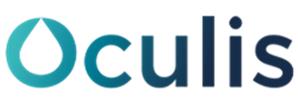
OCS-01, First Investigational Eye Drop for Front and Back of the Eye, Met Both Primary Endpoints in Phase 3 OPTIMIZE Trial with a Once Daily Regimen for the Treatment of Inflammation and Pain Following Cataract Surgery
| • | Once daily OCS-01 meets primary endpoints demonstrating superior reduction in inflammation and pain vs. vehicle following cataract surgery |
| • | OPTIMIZE’s results follow the positive and statistically significant top line results from stage 1 of the Phase 3 DIAMOND trial in Diabetic Macular Edema (DME) reported earlier this year, further highlighting the product’s potential for treating front- and back-of-the-eye diseases |
| • | If approved, OCS-01 has the potential to become a new standard of care as the first once-daily, topical, preservative-free corticosteroid for treating inflammation and pain following ocular surgery |
| • | An investor and analyst call will be held today at 8:00am US Eastern Time, details below |
ZUG, Switzerland, and BOSTON, USA, August 8, 2023 – Oculis Holding AG (Nasdaq: OCS) (“Oculis”), a global biopharmaceutical company purposefully driven to save sight and improve eye care, announced today positive top line results from its Phase 3 OPTIMIZE trial with OCS-01 eye drops, a novel, once-daily, high concentration, preservative-free, topical OPTIREACH® formulation of dexamethasone for the treatment of inflammation and pain following ocular surgery.
Positive Phase 3 Results Show Potential for Once-Daily Treatment following Ocular Surgery
OPTIMIZE (Once-daily Post-ocular surgery Treatment for InflaMmation and paIn to minimiZE drops) is a double-blind, placebo-controlled Phase 3 trial conducted in 25 sites across the US with 241 patients randomized 1:1 to receive once daily (QD) OCS-01 eye drop (n=119) or vehicle (n=122) for fourteen (14) days following cataract surgery.
The trial met both hierarchical primary efficacy endpoints, the absence of inflammation at Day 15 and the absence of pain at Day 4, with robust statistical significance:
| • | Inflammation: the percentage of eyes with zero inflammation (absence of anterior chamber cells, score = 0) was statistically significantly greater with OCS-01 QD compared with vehicle at Day 15 (OCS-01, 57.2% vs vehicle, 24.0%, p<0.0001). |
| • | Pain: the percentage of eyes with zero pain (absence of pain, score = 0) was statistically significantly greater with OCS-01 QD compared with vehicle at Day 4 (OCS-01, 75.5% vs vehicle, 52.0%, p<0.0001). |
Furthermore, OCS-01 was well tolerated with a favorable safety profile. Overall, a higher number of ocular treatment emergent adverse events (TEAEs) were reported for the vehicle group (n=84) compared with the OCS-01 QD group (n=37). There was no meaningful difference in intraocular pressure (IOP) between treatment groups with a mean change from baseline to Day 15 of -0.90 mmHg in both the OCS-01 group and the vehicle group.
OPTIMIZE results in reduction of inflammation and pain and safety observations were consistent with those observed in the Phase 2 SKYGGN trial with once daily administration. In the SKYGGN trial, the same two hierarchical primary efficacy endpoints were also met with robust statistical significance and with similar numerical values.
If approved, OCS-01 has the potential to become a new standard of care and the first once-daily, topical, preservative-free corticosteroid for treating inflammation and pain following ocular surgery.

The Phase 3 OPTIMIZE positive top line readout with OCS-01 once daily eye drops in inflammation and pain following ocular surgery follows the statistically significant top line results of OCS-01 from stage 1 of the Phase 3 DIAMOND trial in Diabetic Macular Edema (DME) reported earlier this year, further highlighting the product’s potential for treating front- and back-of-the-eye diseases. The results also follow the initiation of the LEOPARD investigator-initiated trial evaluating the potential of OCS-01 for the treatment of Cystoid Macular Edema, one of the most significant causes of vision loss following cataract surgery.
Eric Donnenfeld MD, Co-chair of Oculis’ Scientific Advisory Board, said: “The results of the Phase 3 OPTIMIZE trial are exciting because once daily OCS-01 showed to be superior and highly potent in reducing inflammation and pain compared to vehicle with a favorable safety profile. This is significant for patients who have undergone cataract surgery, as they currently need to self-administer multiple daily doses of eye drops to alleviate inflammation and pain. The availability of a preservative-free treatment that requires only a once-daily eye drop could greatly benefit a large number of patients who undergo ocular surgeries worldwide.”
Riad Sherif MD, Chief Executive Officer of Oculis, commented: “I am very pleased with the positive readout of OPTIMIZE. A once daily topical steroid eye drop has shown solid results in reduction of inflammation and pain and offers the potential of a truly simplified dosing regimen. We are on track to advance OCS-01 for inflammation and pain following ocular surgery towards an NDA submission with FDA. We now have positive Phase 3 top line results with OCS-01 preservative-free eye drops in treating front-of-the-eye inflammation and pain following ocular surgery, as well as Stage 1 Phase 3 results for back-of-the-eye diabetic macular edema (DME) from the DIAMOND program, opening for the first time ever new opportunities for topical eye drops to address highly unmet patient needs in both front- and back-of-the-eye indications.”
About inflammation and pain post ocular surgery
Due to the aging population, lifestyle changes and several other factors, ophthalmic surgical procedures are on the rise and are expected to reach close to 10 million procedures per year in the US alone by 20371,2. Cataract surgeries are the most prevalent procedures of all medical specialties with an estimated 5.3 million procedures in 2021 for the US alone2. Ophthalmic procedures promote the release of inflammatory factors and can be associated with ocular pain. Cataract surgery, while the incision is very small, creates inflammation in the cornea, anterior chamber, and iris. Ophthalmologists currently rely on topical steroids to treat ocular inflammation and the full regimen following ocular surgery often includes steroids, antibiotics and NSAID, which can require several drops daily for a post-op patient to self-administer, which may lead to compliance issues.
About OCS-01 eye drops and the OPTIREACH® technology
Leveraging Oculis’ proprietary OPTIREACH® technology, OCS-01 is a novel, high concentration (15 mg/ml), topical formulation of dexamethasone. The OPTIREACH® solubilizing formulation technology addresses the main limitations of conventional eye drops by improving the solubility of lipophilic drugs, increasing the residence time on the eye surface and thereby, enabling less frequent administration for front-of-the-eye and the drug passage from the eye surface to the posterior segment for back-of-the-eye diseases.
Analyst and investor call
The Oculis management team will host an analyst and investor call today at 8:00 am US Eastern Time, to review the trial results. The principal investigator for the OPTIMIZE trial, Michael Korenfeld, M.D. (USA) and Eric Donnenfeld, M.D. (USA) will be present to answer clinical questions during the live Q&A session.
To access the live event online, please pre-register for the webcast here.
A replay of the webcast and accompanying slides will be available for 90 days following the event through the “Events and Presentations” page of the “Investors and Media” section of the company’s website.
| 1 | 2016 HCUP procedure volume and growth rate, and corroborated by Rochester Epidemiology Project Paper. Third party market research. |
| 2 | Meddevicetracker – Ophthalmic Surgical Products Market 2017. |
-ENDS-

About Oculis
Oculis (Nasdaq: OCS) is a global biopharmaceutical company purposefully driven to save sight and improve eye care. Oculis’ highly differentiated clinical-stage pipeline comprises multiple innovative product candidates in development for eye diseases of high unmet need. It includes OCS-01 eye drops, a topical candidate in Phase 3 development for diabetic macular edema (DME) and inflammation and pain following ocular surgery; OCS-02 eye drops, a topical biologic candidate in Phase 2 development for dry eye disease (DED) and uveitis; and OCS-05, a disease modifying candidate for acute optic neuritis (AON) and other neuro-ophthalmic disorders, such as glaucoma, diabetic retinopathy, geographic atrophy, and neurotrophic keratitis. The first in-patient, proof-of-concept trial with OCS-05 is currently ongoing in France. Headquartered in Switzerland and with operations in the US, Oculis’ goal is to deliver life-changing eye treatments to patients worldwide. The company is led by an experienced management team with a successful track record in the pharmaceutical industry, supported by leading international healthcare investors.
For more information, please visit: www.oculis.com
Oculis Contacts
Ms. Sylvia Cheung, CFO
sylvia.cheung@oculis.com
Investor & Media Relations
LifeSci Advisors
Corey Davis, Ph.D.
cdavis@lifesciadvisors.com
1-212-915-2577
Cautionary Statement Regarding Forward Looking Statements
This press release contains forward-looking statements and information. For example, statements regarding the potential benefits of OCS-01, including patient impact and market opportunity; the potential of OCS-01 for treating front- and back-of-the-eye diseases; the potential for OCS-01 to become a new standard of care with the first once-daily, topical, preservative-free corticosteroid for treating inflammation and pain following ocular surgery; the potential of OCS-01 for the treatment of Cystoid Macular Edema; expected future milestones and catalysts; the initiation, timing, progress and results of Oculis’ clinical and preclinical studies; Oculis’ research and development programs, regulatory and business strategy, future development plans, and management; Oculis’ ability to advance product candidates into, and successfully complete, clinical trials; and the timing or likelihood of regulatory filings and approvals, are forward-looking. All forward-looking statements are based on estimates and assumptions that, while considered reasonable by Oculis and its management, are inherently uncertain and are inherently subject to risks, variability and contingencies, many of which are beyond Oculis’ control.

These forward-looking statements are provided for illustrative purposes only and are not intended to serve as, and must not be relied on by an investor as, a guarantee, assurance, prediction or definitive statement of a fact or probability. Actual events and circumstances are difficult or impossible to predict and will differ from assumptions. All forward-looking statements are subject to risks, uncertainties and other factors that may cause actual results to differ materially from those that we expected and/or those expressed or implied by such forward-looking statements. Forward-looking statements are subject to numerous conditions, many of which are beyond the control of Oculis, including those set forth in the Risk Factors section of Oculis’ annual report on Form 20-F and any other documents filed with the U.S. Securities and Exchange Commission (the “SEC”). Copies of these documents are available on the SEC’s website, www.sec.gov. Oculis undertakes no obligation to update these statements for revisions or changes after the date of this release, except as required by law.
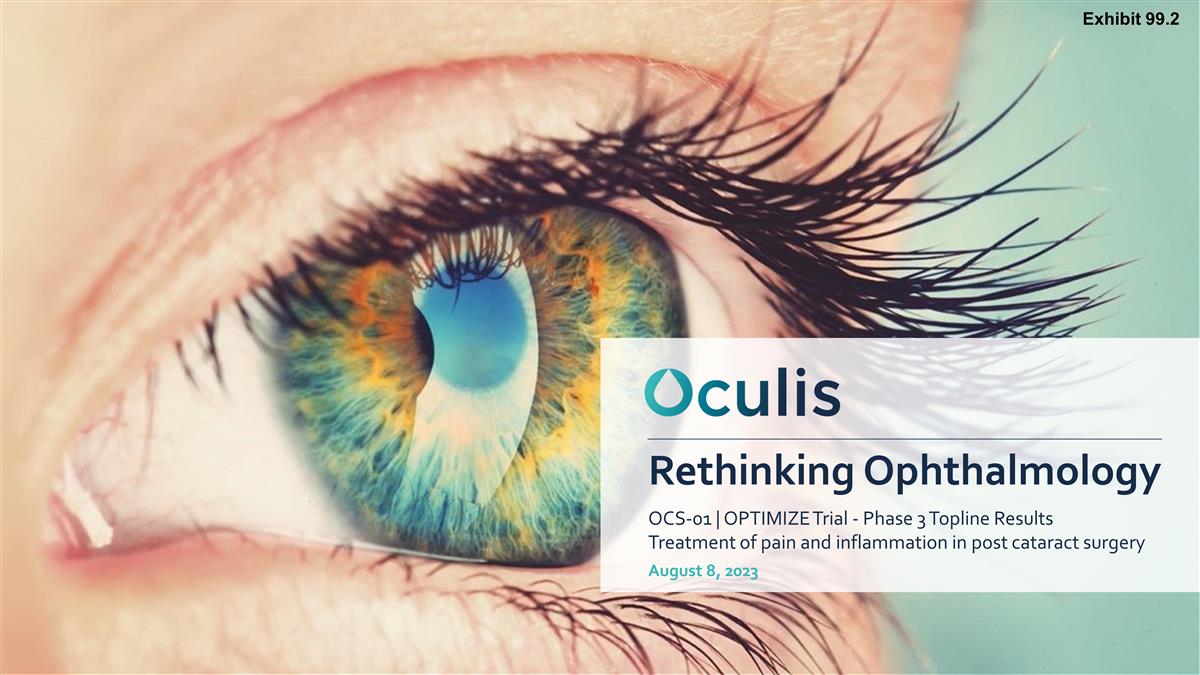
OCS-01 | OPTIMIZE Trial - Phase 3 Topline Results Treatment of pain and inflammation in post cataract surgery August 8, 2023 Rethinking Ophthalmology Exhibit 99.2
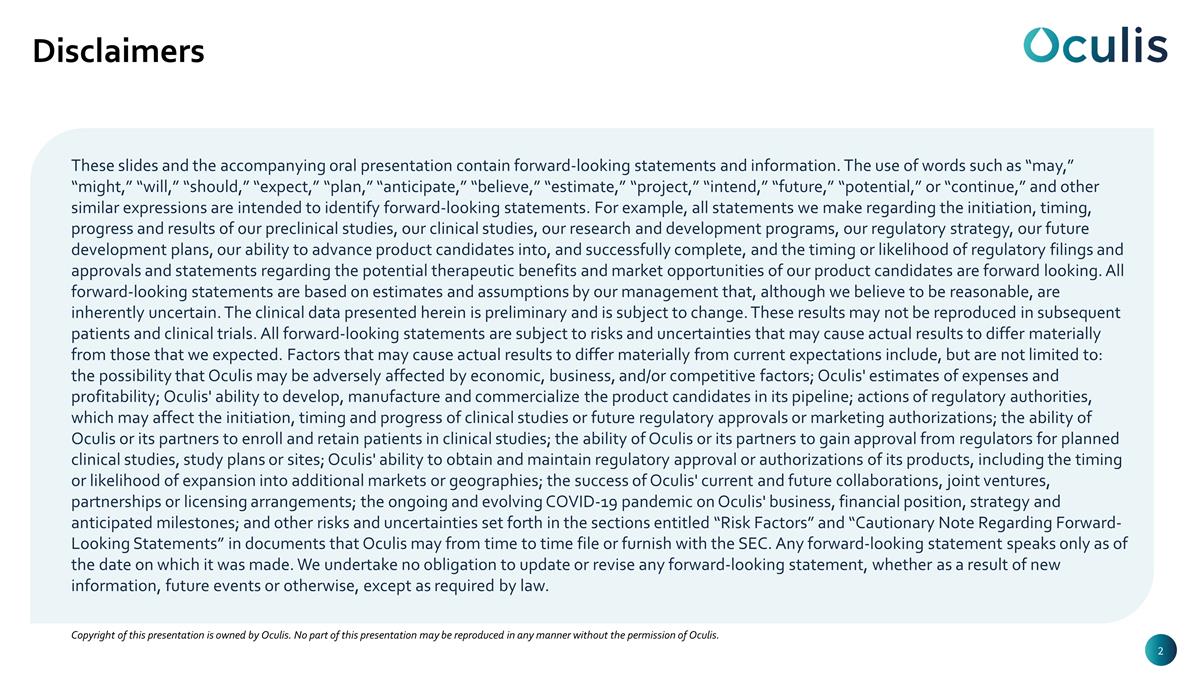
These slides and the accompanying oral presentation contain forward-looking statements and information. The use of words such as “may,” “might,” “will,” “should,” “expect,” “plan,” “anticipate,” “believe,” “estimate,” “project,” “intend,” “future,” “potential,” or “continue,” and other similar expressions are intended to identify forward-looking statements. For example, all statements we make regarding the initiation, timing, progress and results of our preclinical studies, our clinical studies, our research and development programs, our regulatory strategy, our future development plans, our ability to advance product candidates into, and successfully complete, and the timing or likelihood of regulatory filings and approvals and statements regarding the potential therapeutic benefits and market opportunities of our product candidates are forward looking. All forward-looking statements are based on estimates and assumptions by our management that, although we believe to be reasonable, are inherently uncertain. The clinical data presented herein is preliminary and is subject to change. These results may not be reproduced in subsequent patients and clinical trials. All forward-looking statements are subject to risks and uncertainties that may cause actual results to differ materially from those that we expected. Factors that may cause actual results to differ materially from current expectations include, but are not limited to: the possibility that Oculis may be adversely affected by economic, business, and/or competitive factors; Oculis' estimates of expenses and profitability; Oculis' ability to develop, manufacture and commercialize the product candidates in its pipeline; actions of regulatory authorities, which may affect the initiation, timing and progress of clinical studies or future regulatory approvals or marketing authorizations; the ability of Oculis or its partners to enroll and retain patients in clinical studies; the ability of Oculis or its partners to gain approval from regulators for planned clinical studies, study plans or sites; Oculis' ability to obtain and maintain regulatory approval or authorizations of its products, including the timing or likelihood of expansion into additional markets or geographies; the success of Oculis' current and future collaborations, joint ventures, partnerships or licensing arrangements; the ongoing and evolving COVID-19 pandemic on Oculis' business, financial position, strategy and anticipated milestones; and other risks and uncertainties set forth in the sections entitled “Risk Factors” and “Cautionary Note Regarding Forward-Looking Statements” in documents that Oculis may from time to time file or furnish with the SEC. Any forward-looking statement speaks only as of the date on which it was made. We undertake no obligation to update or revise any forward-looking statement, whether as a result of new information, future events or otherwise, except as required by law. Copyright of this presentation is owned by Oculis. No part of this presentation may be reproduced in any manner without the permission of Oculis. Disclaimers
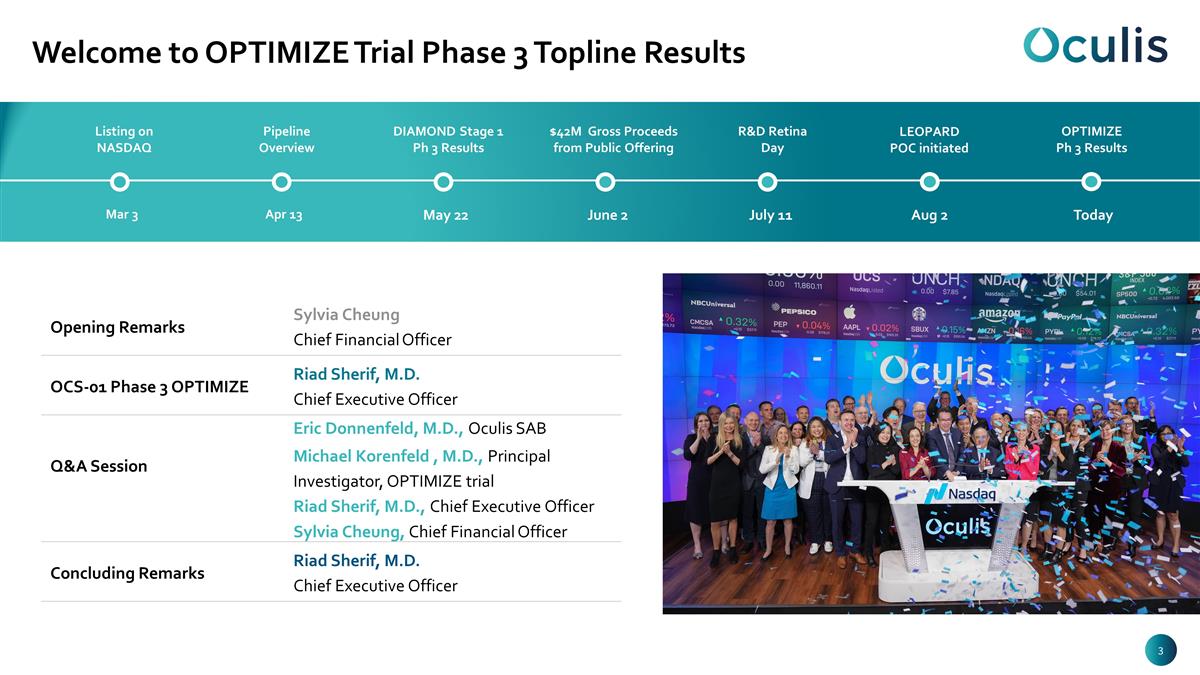
Welcome to OPTIMIZE Trial Phase 3 Topline Results Opening Remarks Sylvia Cheung Chief Financial Officer OCS-01 Phase 3 OPTIMIZE Riad Sherif, M.D. Chief Executive Officer Q&A Session Eric Donnenfeld, M.D., Oculis SAB Michael Korenfeld , M.D., Principal Investigator, OPTIMIZE trial Riad Sherif, M.D., Chief Executive Officer Sylvia Cheung, Chief Financial Officer Concluding Remarks Riad Sherif, M.D. Chief Executive Officer Listing on NASDAQ DIAMOND Stage 1 Ph 3 Results R&D Retina Day OPTIMIZE Ph 3 Results Pipeline Overview $42M Gross Proceeds from Public Offering LEOPARD POC initiated Mar 3 Apr 13 May 22 June 2 July 11 Aug 2 Today
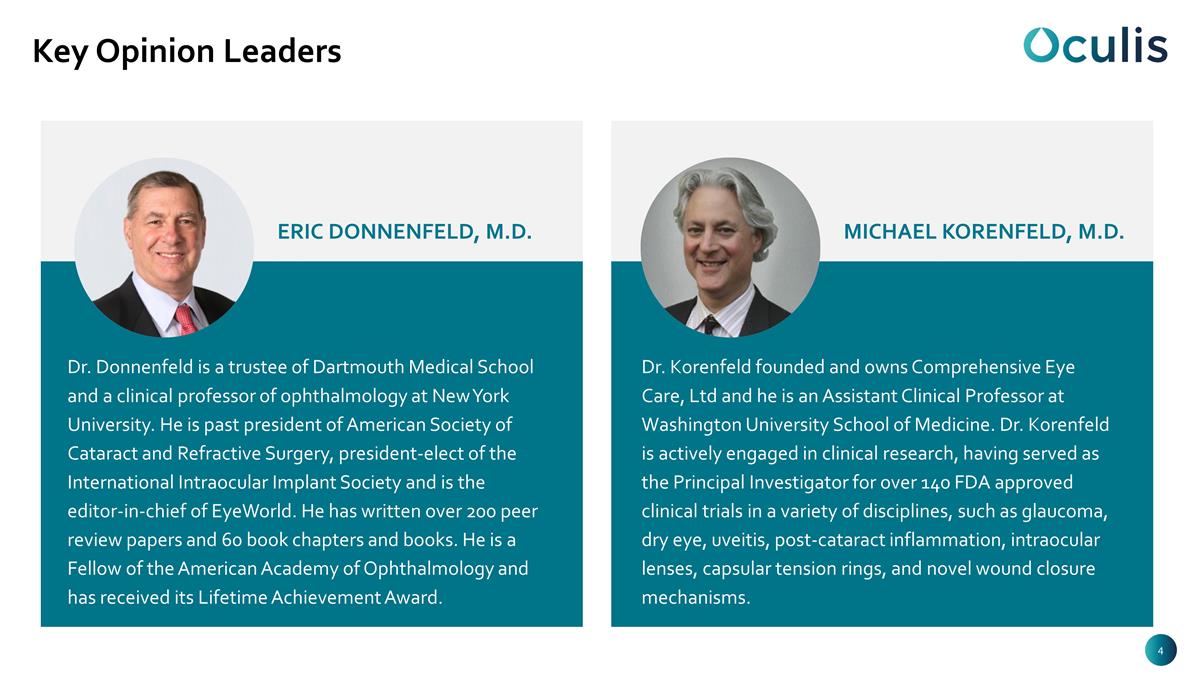
Key Opinion Leaders ERIC DONNENFELD, M.D. Dr. Donnenfeld is a trustee of Dartmouth Medical School and a clinical professor of ophthalmology at New York University. He is past president of American Society of Cataract and Refractive Surgery, president-elect of the International Intraocular Implant Society and is the editor-in-chief of EyeWorld. He has written over 200 peer review papers and 60 book chapters and books. He is a Fellow of the American Academy of Ophthalmology and has received its Lifetime Achievement Award. MICHAEL KORENFELD, M.D. Dr. Korenfeld founded and owns Comprehensive Eye Care, Ltd and he is an Assistant Clinical Professor at Washington University School of Medicine. Dr. Korenfeld is actively engaged in clinical research, having served as the Principal Investigator for over 140 FDA approved clinical trials in a variety of disciplines, such as glaucoma, dry eye, uveitis, post-cataract inflammation, intraocular lenses, capsular tension rings, and novel wound closure mechanisms.
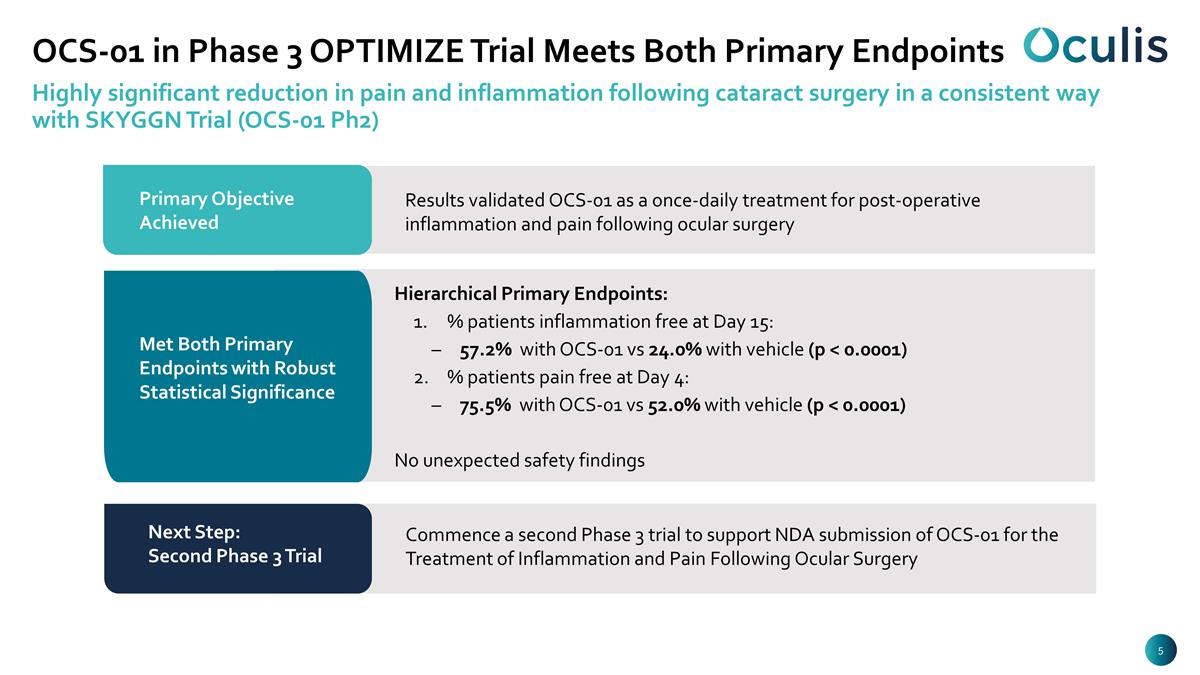
OCS-01 in Phase 3 OPTIMIZE Trial Meets Both Primary Endpoints Highly significant reduction in pain and inflammation following cataract surgery in a consistent way with SKYGGN Trial (OCS-01 Ph2) Next Step: Second Phase 3 Trial Commence a second Phase 3 trial to support NDA submission of OCS-01 for the Treatment of Inflammation and Pain Following Ocular Surgery Primary Objective Achieved Results validated OCS-01 as a once-daily treatment for post-operative inflammation and pain following ocular surgery Met Both Primary Endpoints with Robust Statistical Significance Hierarchical Primary Endpoints: % patients inflammation free at Day 15: 57.2% with OCS-01 vs 24.0% with vehicle (p < 0.0001) % patients pain free at Day 4: 75.5% with OCS-01 vs 52.0% with vehicle (p < 0.0001) No unexpected safety findings
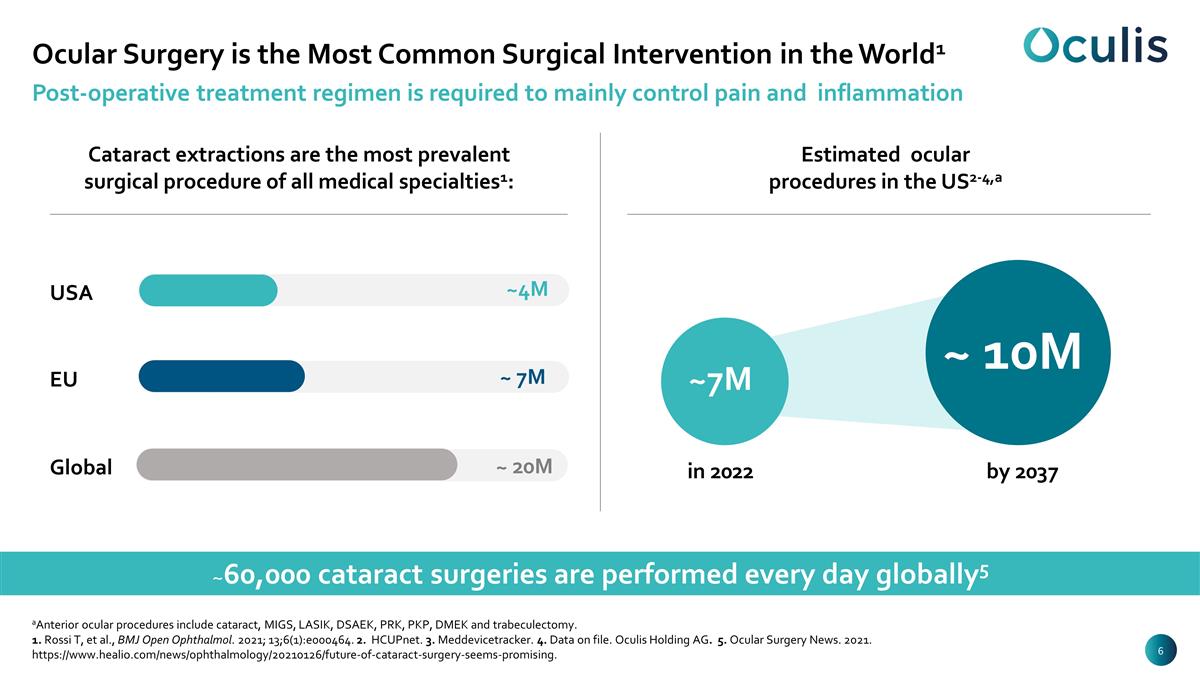
Ocular Surgery is the Most Common Surgical Intervention in the World1 Post-operative treatment regimen is required to mainly control pain and inflammation Cataract extractions are the most prevalent surgical procedure of all medical specialties1: aAnterior ocular procedures include cataract, MIGS, LASIK, DSAEK, PRK, PKP, DMEK and trabeculectomy. 1. Rossi T, et al., BMJ Open Ophthalmol. 2021; 13;6(1):e000464. 2. HCUPnet. 3. Meddevicetracker. 4. Data on file. Oculis Holding AG. 5. Ocular Surgery News. 2021. https://www.healio.com/news/ophthalmology/20210126/future-of-cataract-surgery-seems-promising. Estimated ocular procedures in the US2-4,a ~ 10M ~60,000 cataract surgeries are performed every day globally5 ~7M in 2022 by 2037 Global ~4M ~ 7M ~ 20M EU USA
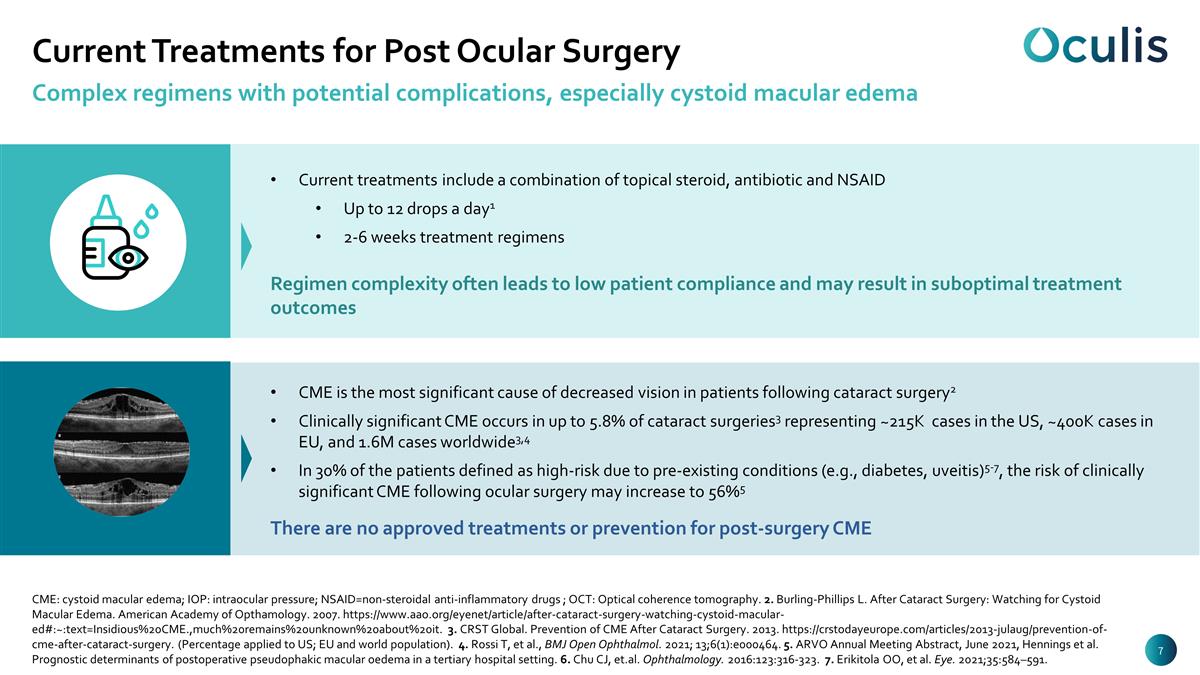
Current Treatments for Post Ocular Surgery Complex regimens with potential complications, especially cystoid macular edema Current treatments include a combination of topical steroid, antibiotic and NSAID Up to 12 drops a day1 2-6 weeks treatment regimens CME: cystoid macular edema; IOP: intraocular pressure; NSAID=non-steroidal anti-inflammatory drugs ; OCT: Optical coherence tomography. 2. Burling-Phillips L. After Cataract Surgery: Watching for Cystoid Macular Edema. American Academy of Opthamology. 2007. https://www.aao.org/eyenet/article/after-cataract-surgery-watching-cystoid-macular-ed#:~:text=Insidious%20CME.,much%20remains%20unknown%20about%20it. 3. CRST Global. Prevention of CME After Cataract Surgery. 2013. https://crstodayeurope.com/articles/2013-julaug/prevention-of-cme-after-cataract-surgery. (Percentage applied to US; EU and world population). 4. Rossi T, et al., BMJ Open Ophthalmol. 2021; 13;6(1):e000464. 5. ARVO Annual Meeting Abstract, June 2021, Hennings et al. Prognostic determinants of postoperative pseudophakic macular oedema in a tertiary hospital setting. 6. Chu CJ, et.al. Ophthalmology. 2016:123:316-323. 7. Erikitola OO, et al. Eye. 2021;35:584–591. Regimen complexity often leads to low patient compliance and may result in suboptimal treatment outcomes CME is the most significant cause of decreased vision in patients following cataract surgery2 Clinically significant CME occurs in up to 5.8% of cataract surgeries3 representing ~215K cases in the US, ~400K cases in EU, and 1.6M cases worldwide3,4 In 30% of the patients defined as high-risk due to pre-existing conditions (e.g., diabetes, uveitis)5-7, the risk of clinically significant CME following ocular surgery may increase to 56%5 There are no approved treatments or prevention for post-surgery CME
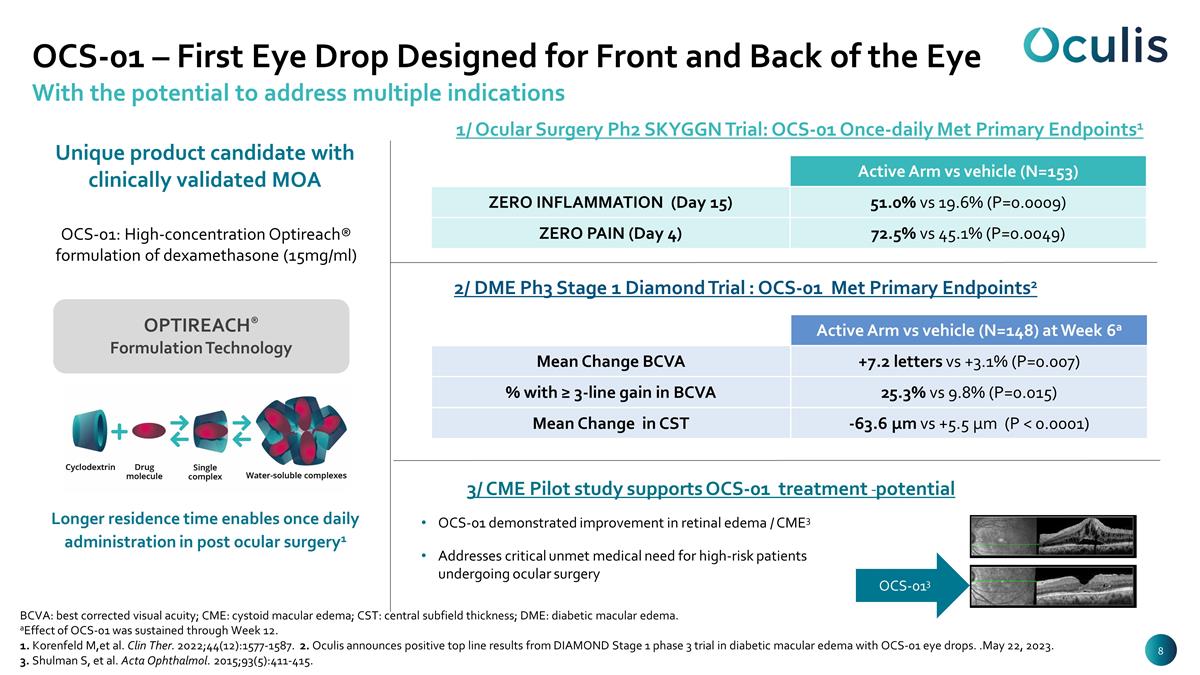
With the potential to address multiple indications Unique product candidate with clinically validated MOA OCS-01: High-concentration Optireach® formulation of dexamethasone (15mg/ml) OPTIREACH® Formulation Technology Longer residence time enables once daily administration in post ocular surgery1 BCVA: best corrected visual acuity; CME: cystoid macular edema; CST: central subfield thickness; DME: diabetic macular edema. aEffect of OCS-01 was sustained through Week 12. 1. Korenfeld M,et al. Clin Ther. 2022;44(12):1577-1587. 2. Oculis announces positive top line results from DIAMOND Stage 1 phase 3 trial in diabetic macular edema with OCS-01 eye drops. .May 22, 2023. 3. Shulman S, et al. Acta Ophthalmol. 2015;93(5):411-415. OCS-01 – First Eye Drop Designed for Front and Back of the Eye 2/ DME Ph3 Stage 1 Diamond Trial : OCS-01 Met Primary Endpoints2 Active Arm vs vehicle (N=148) at Week 6a Mean Change BCVA +7.2 letters vs +3.1% (P=0.007) % with ≥ 3-line gain in BCVA 25.3% vs 9.8% (P=0.015) Mean Change in CST -63.6 μm vs +5.5 μm (P < 0.0001) 3/ CME Pilot study supports OCS-01 treatment potential OCS-01 demonstrated improvement in retinal edema / CME3 Addresses critical unmet medical need for high-risk patients undergoing ocular surgery 1/ Ocular Surgery Ph2 SKYGGN Trial: OCS-01 Once-daily Met Primary Endpoints1 Active Arm vs vehicle (N=153) ZERO INFLAMMATION (Day 15) 51.0% vs 19.6% (P=0.0009) ZERO PAIN (Day 4) 72.5% vs 45.1% (P=0.0049) OCS-013
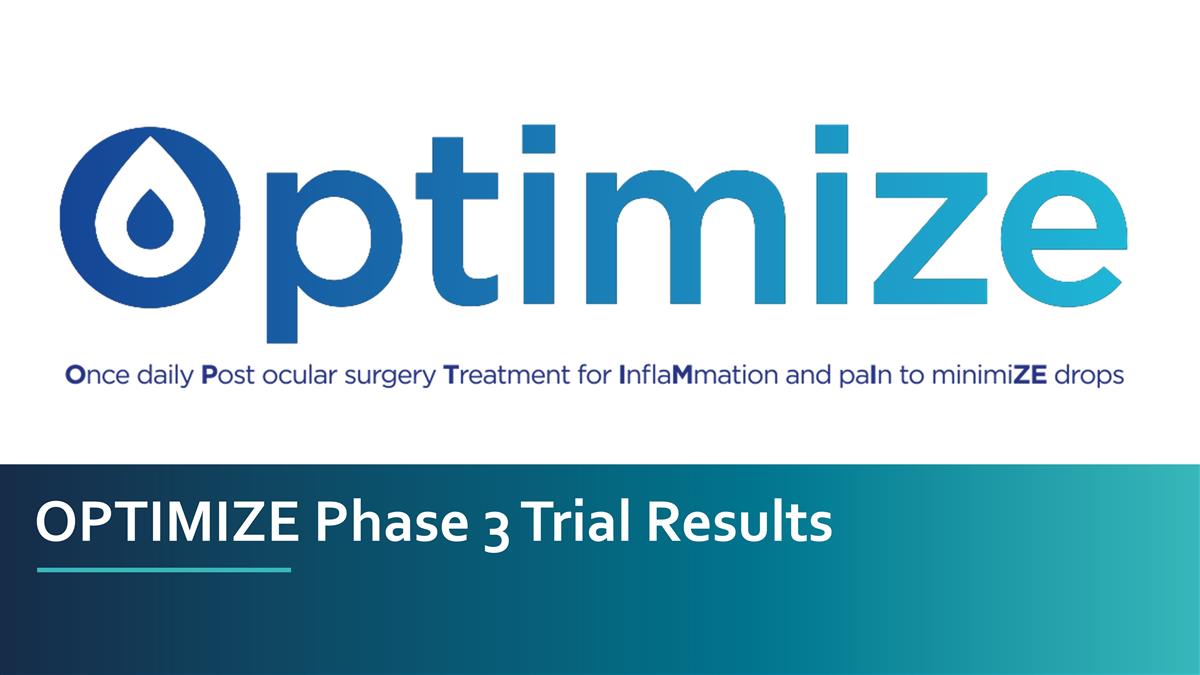
OPTIMIZE Phase 3 Trial Results
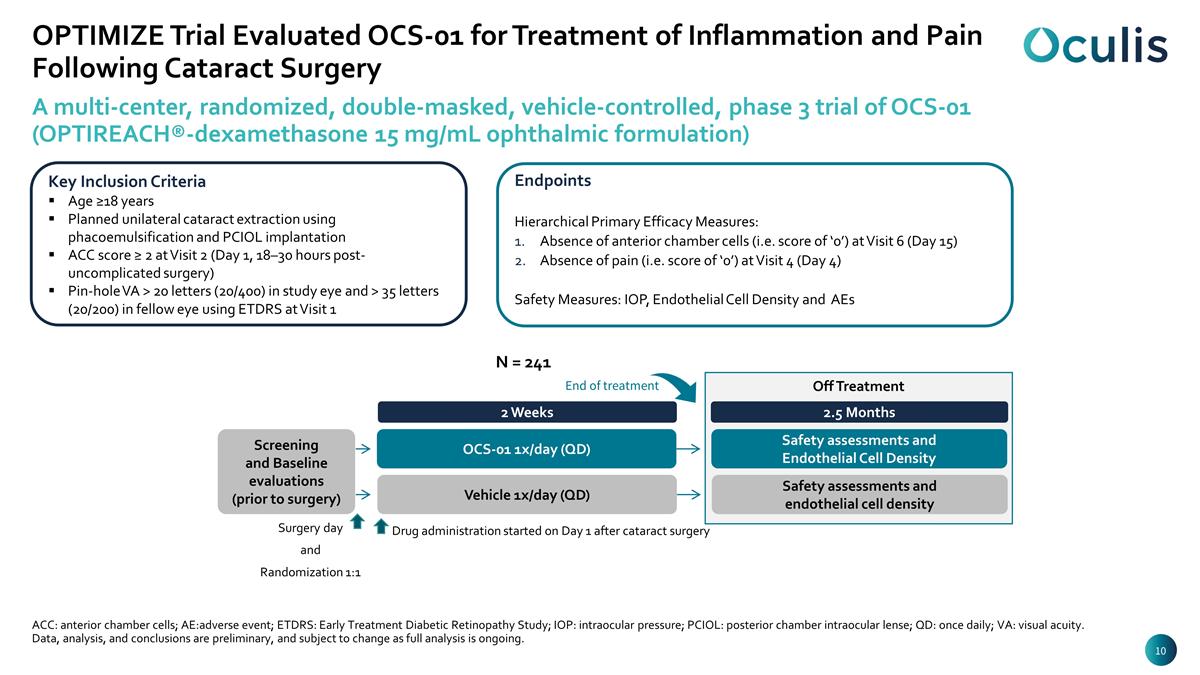
OPTIMIZE Trial Evaluated OCS-01 for Treatment of Inflammation and Pain Following Cataract Surgery A multi-center, randomized, double-masked, vehicle-controlled, phase 3 trial of OCS-01 (OPTIREACH®-dexamethasone 15 mg/mL ophthalmic formulation) ACC: anterior chamber cells; AE:adverse event; ETDRS: Early Treatment Diabetic Retinopathy Study; IOP: intraocular pressure; PCIOL: posterior chamber intraocular lense; QD: once daily; VA: visual acuity. Data, analysis, and conclusions are preliminary, and subject to change as full analysis is ongoing. 2 Weeks OCS-01 1x/day (QD) Screening and Baseline evaluations (prior to surgery) Vehicle 1x/day (QD) Key Inclusion Criteria Age ≥18 years Planned unilateral cataract extraction using phacoemulsification and PCIOL implantation ACC score ≥ 2 at Visit 2 (Day 1, 18–30 hours post-uncomplicated surgery) Pin-hole VA > 20 letters (20/400) in study eye and > 35 letters (20/200) in fellow eye using ETDRS at Visit 1 Endpoints Hierarchical Primary Efficacy Measures: Absence of anterior chamber cells (i.e. score of ‘0’) at Visit 6 (Day 15) Absence of pain (i.e. score of ‘0’) at Visit 4 (Day 4) Safety Measures: IOP, Endothelial Cell Density and AEs End of treatment Off Treatment 2.5 Months Safety assessments and Endothelial Cell Density Safety assessments and endothelial cell density Surgery day and Randomization 1:1 Drug administration started on Day 1 after cataract surgery N = 241
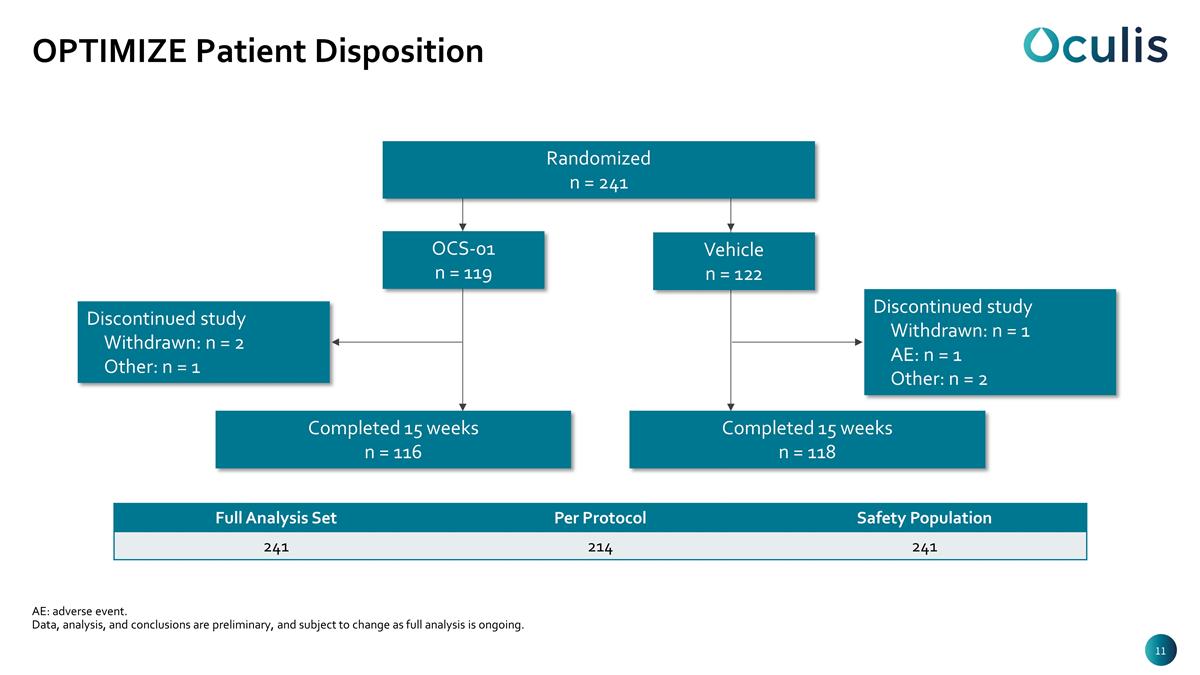
OPTIMIZE Patient Disposition AE: adverse event. Data, analysis, and conclusions are preliminary, and subject to change as full analysis is ongoing. OCS-01 n = 119 Vehicle n = 122 Completed 15 weeks n = 116 Completed 15 weeks n = 118 Discontinued study Withdrawn: n = 1 AE: n = 1 Other: n = 2 Discontinued study Withdrawn: n = 2 Other: n = 1 Randomized n = 241 Full Analysis Set Per Protocol Safety Population 241 214 241
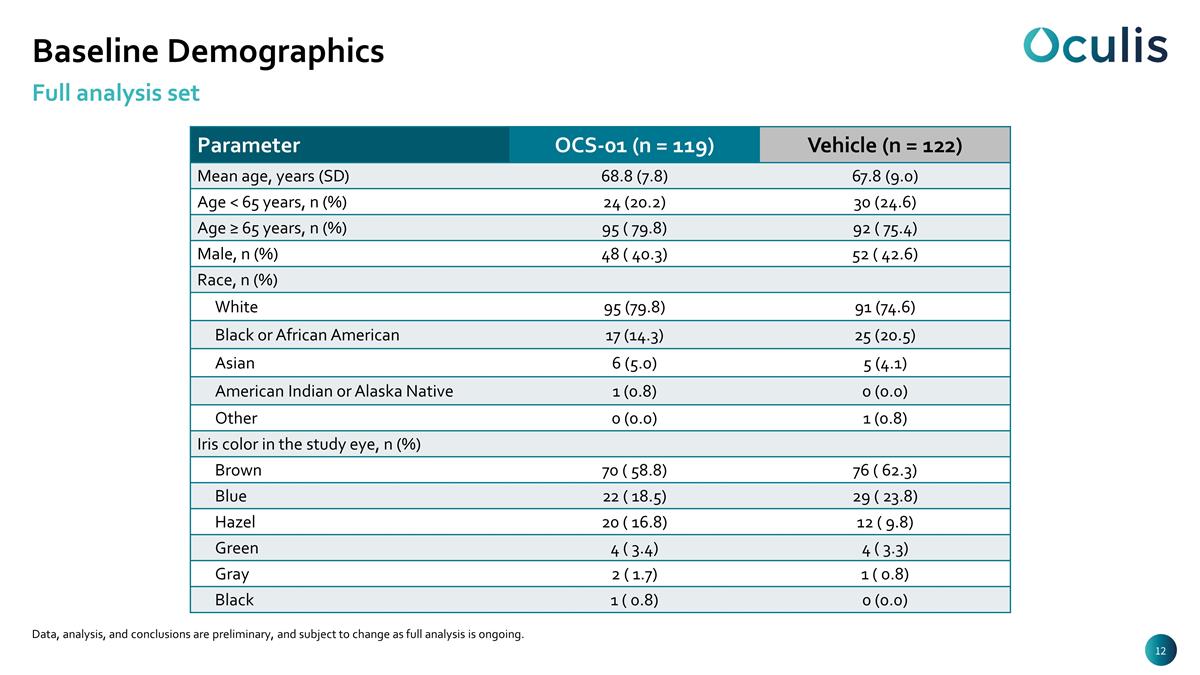
Baseline Demographics Full analysis set Data, analysis, and conclusions are preliminary, and subject to change as full analysis is ongoing. Parameter OCS-01 (n = 119) Vehicle (n = 122) Mean age, years (SD) 68.8 (7.8) 67.8 (9.0) Age < 65 years, n (%) 24 (20.2) 30 (24.6) Age ≥ 65 years, n (%) 95 ( 79.8) 92 ( 75.4) Male, n (%) 48 ( 40.3) 52 ( 42.6) Race, n (%) White 95 (79.8) 91 (74.6) Black or African American 17 (14.3) 25 (20.5) Asian 6 (5.0) 5 (4.1) American Indian or Alaska Native 1 (0.8) 0 (0.0) Other 0 (0.0) 1 (0.8) Iris color in the study eye, n (%) Brown 70 ( 58.8) 76 ( 62.3) Blue 22 ( 18.5) 29 ( 23.8) Hazel 20 ( 16.8) 12 ( 9.8) Green 4 ( 3.4) 4 ( 3.3) Gray 2 ( 1.7) 1 ( 0.8) Black 1 ( 0.8) 0 (0.0)
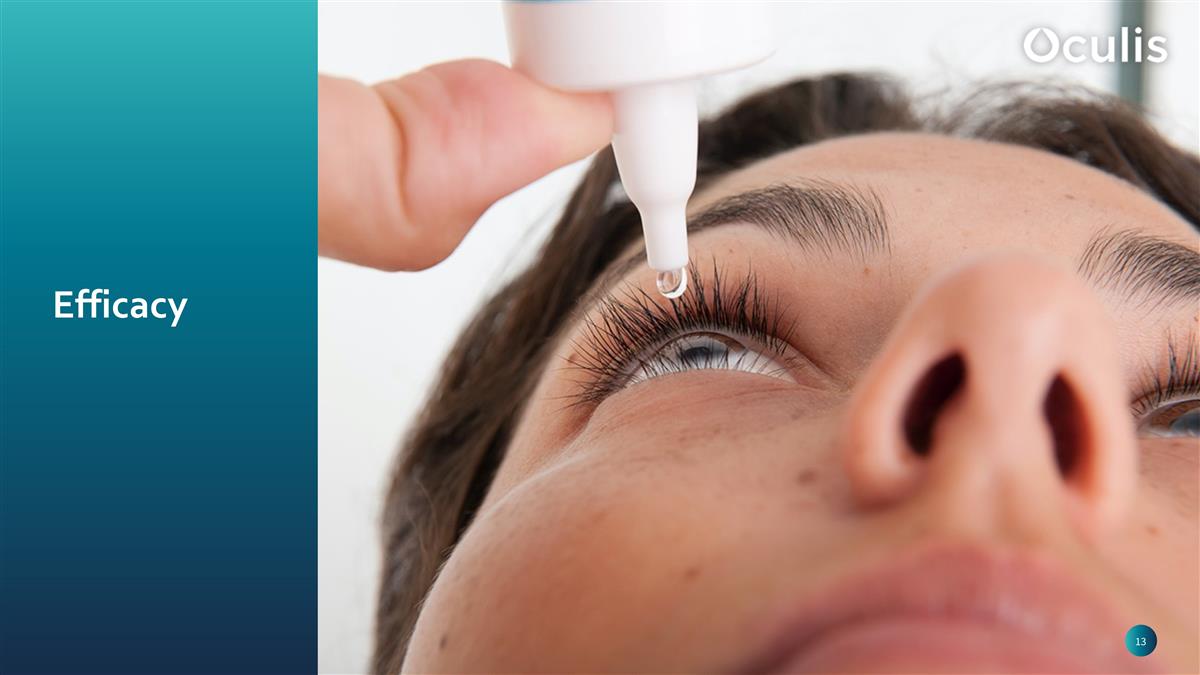
Efficacy
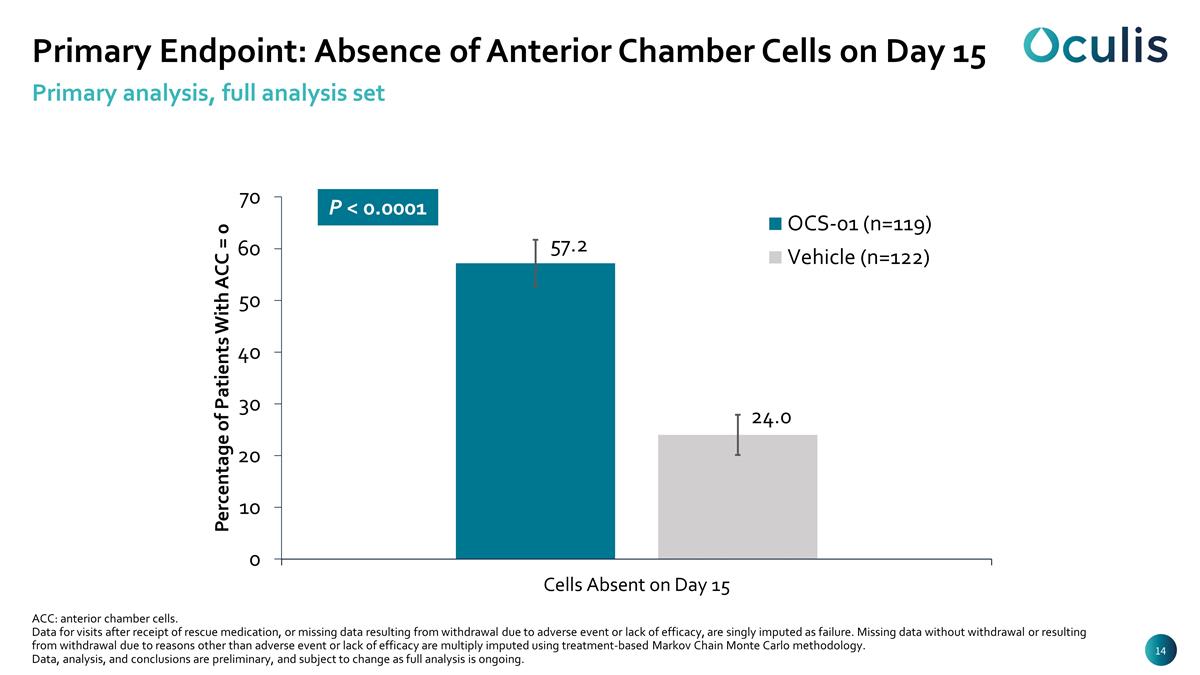
Primary Endpoint: Absence of Anterior Chamber Cells on Day 15 Primary analysis, full analysis set P < 0.0001 ACC: anterior chamber cells. Data for visits after receipt of rescue medication, or missing data resulting from withdrawal due to adverse event or lack of efficacy, are singly imputed as failure. Missing data without withdrawal or resulting from withdrawal due to reasons other than adverse event or lack of efficacy are multiply imputed using treatment-based Markov Chain Monte Carlo methodology. Data, analysis, and conclusions are preliminary, and subject to change as full analysis is ongoing.
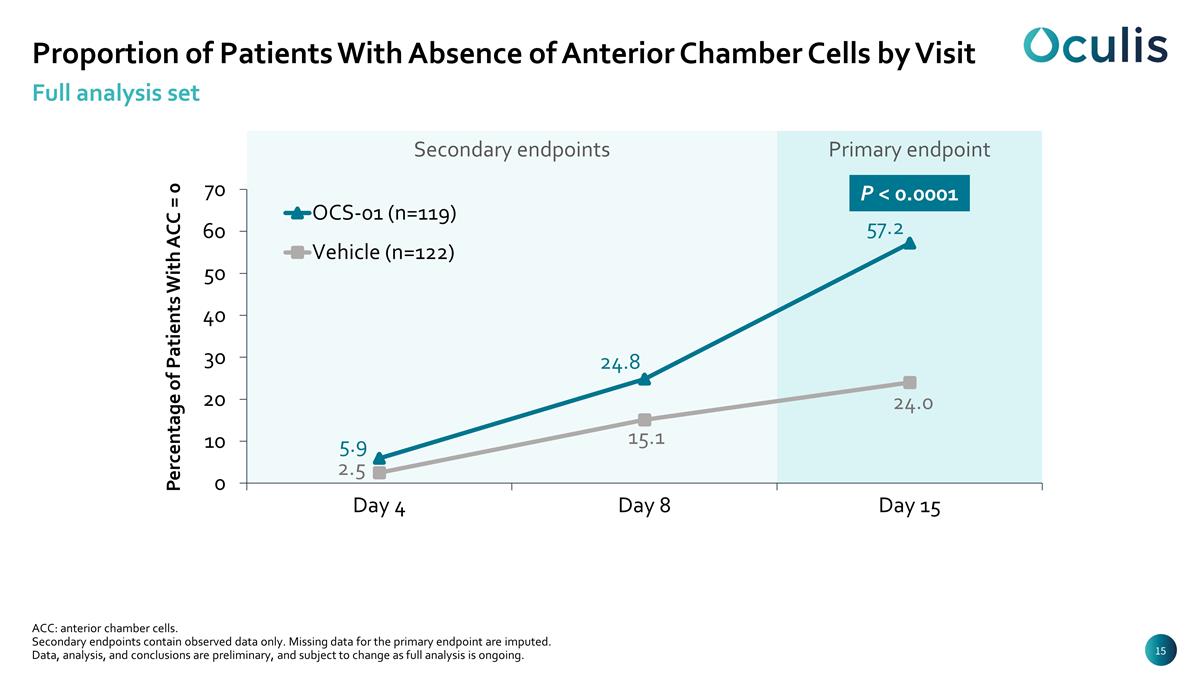
Primary endpoint Secondary endpoints Proportion of Patients With Absence of Anterior Chamber Cells by Visit Full analysis set ACC: anterior chamber cells. Secondary endpoints contain observed data only. Missing data for the primary endpoint are imputed. Data, analysis, and conclusions are preliminary, and subject to change as full analysis is ongoing. P < 0.0001
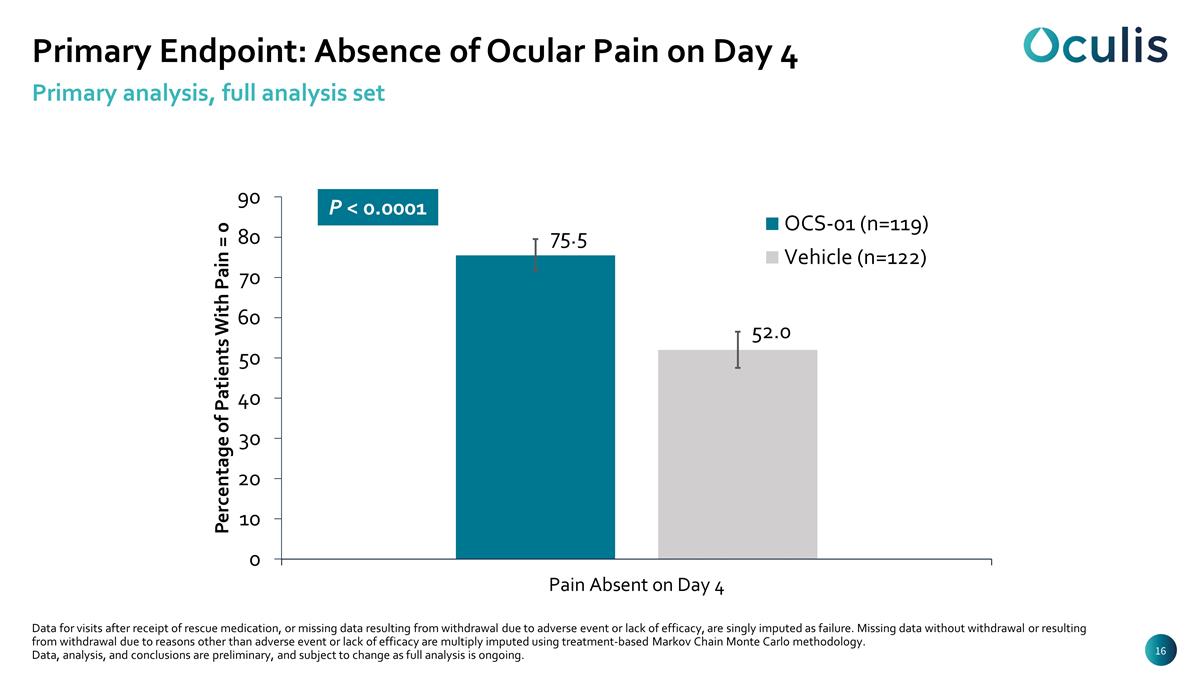
Primary Endpoint: Absence of Ocular Pain on Day 4 Primary analysis, full analysis set P < 0.0001 Data for visits after receipt of rescue medication, or missing data resulting from withdrawal due to adverse event or lack of efficacy, are singly imputed as failure. Missing data without withdrawal or resulting from withdrawal due to reasons other than adverse event or lack of efficacy are multiply imputed using treatment-based Markov Chain Monte Carlo methodology. Data, analysis, and conclusions are preliminary, and subject to change as full analysis is ongoing.
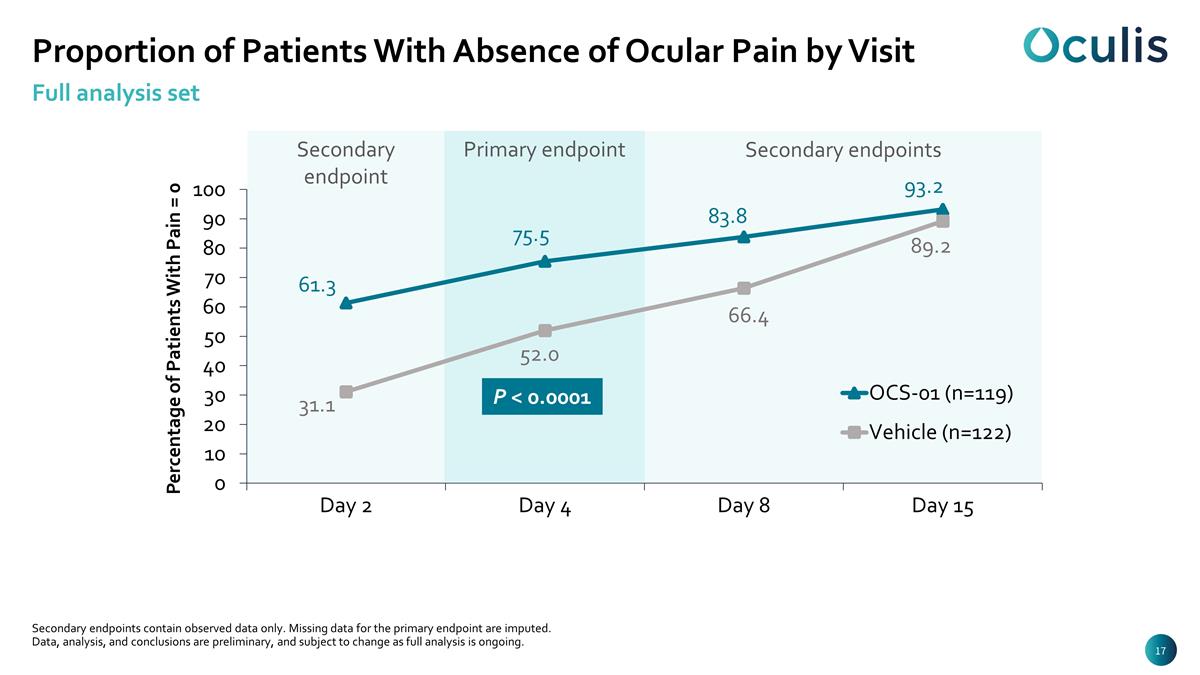
Primary endpoint Secondary endpoint Secondary endpoints Proportion of Patients With Absence of Ocular Pain by Visit Full analysis set Secondary endpoints contain observed data only. Missing data for the primary endpoint are imputed. Data, analysis, and conclusions are preliminary, and subject to change as full analysis is ongoing. P < 0.0001
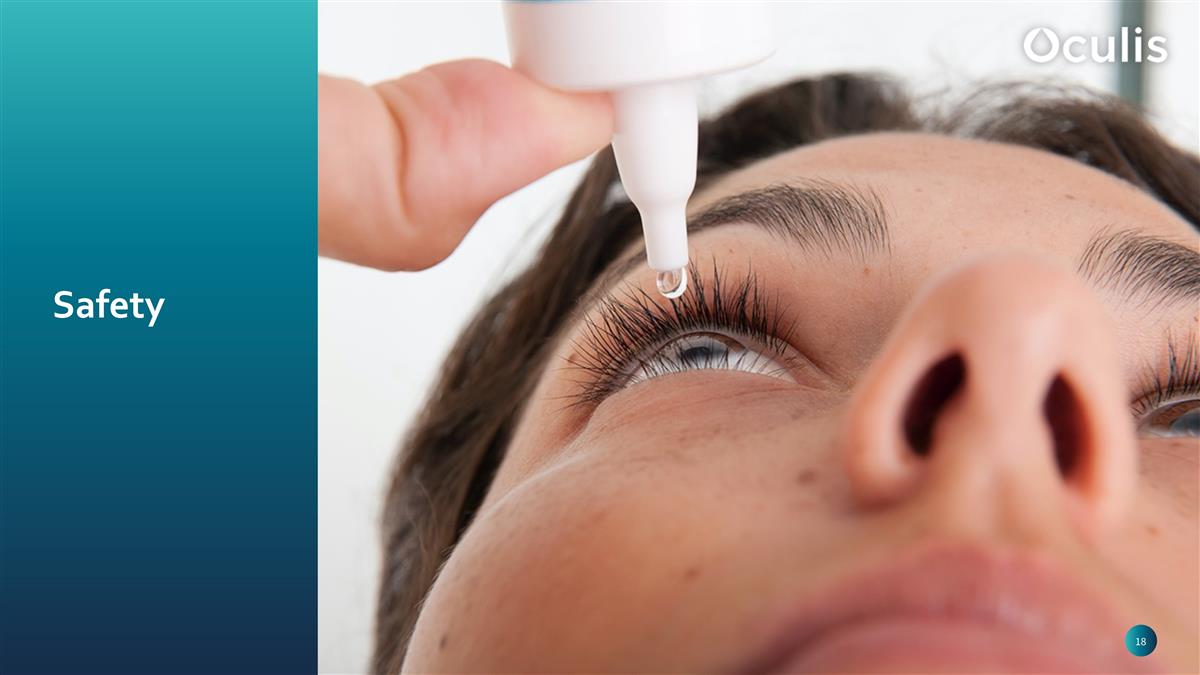
Safety
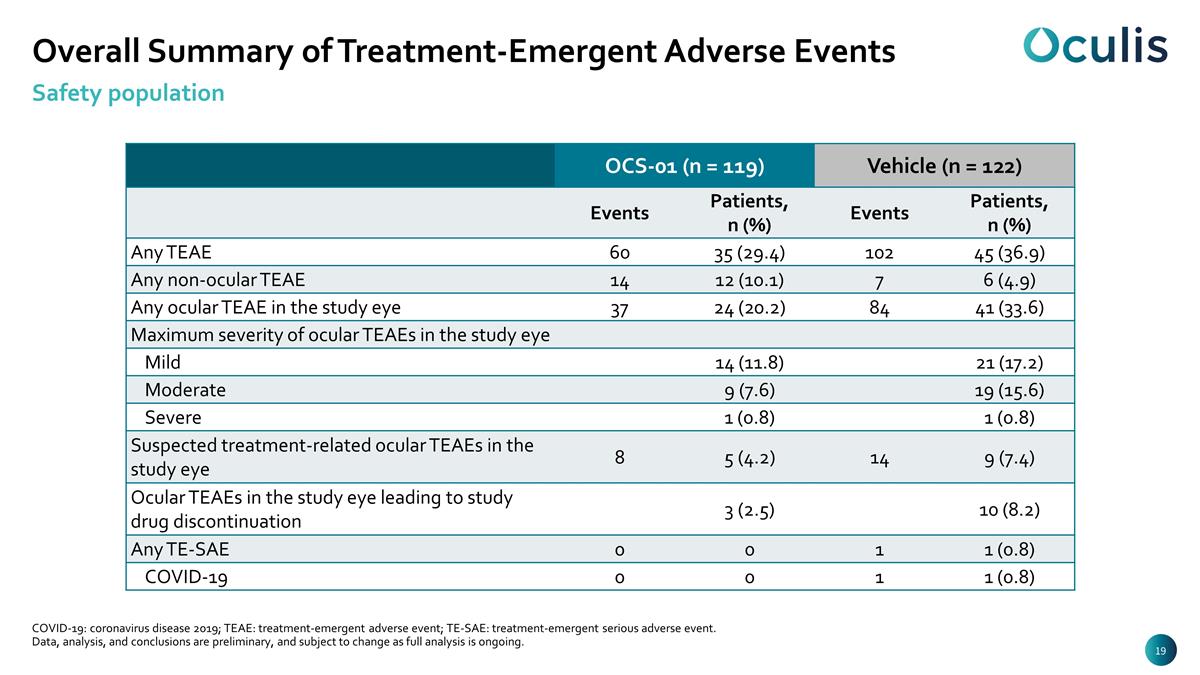
Overall Summary of Treatment-Emergent Adverse Events Safety population COVID-19: coronavirus disease 2019; TEAE: treatment-emergent adverse event; TE-SAE: treatment-emergent serious adverse event. Data, analysis, and conclusions are preliminary, and subject to change as full analysis is ongoing. OCS-01 (n = 119) Vehicle (n = 122) Events Patients, n (%) Events Patients, n (%) Any TEAE 60 35 (29.4) 102 45 (36.9) Any non-ocular TEAE 14 12 (10.1) 7 6 (4.9) Any ocular TEAE in the study eye 37 24 (20.2) 84 41 (33.6) Maximum severity of ocular TEAEs in the study eye Mild 14 (11.8) 21 (17.2) Moderate 9 (7.6) 19 (15.6) Severe 1 (0.8) 1 (0.8) Suspected treatment-related ocular TEAEs in the study eye 8 5 (4.2) 14 9 (7.4) Ocular TEAEs in the study eye leading to study drug discontinuation 3 (2.5) 10 (8.2) Any TE-SAE 0 0 1 1 (0.8) COVID-19 0 0 1 1 (0.8)
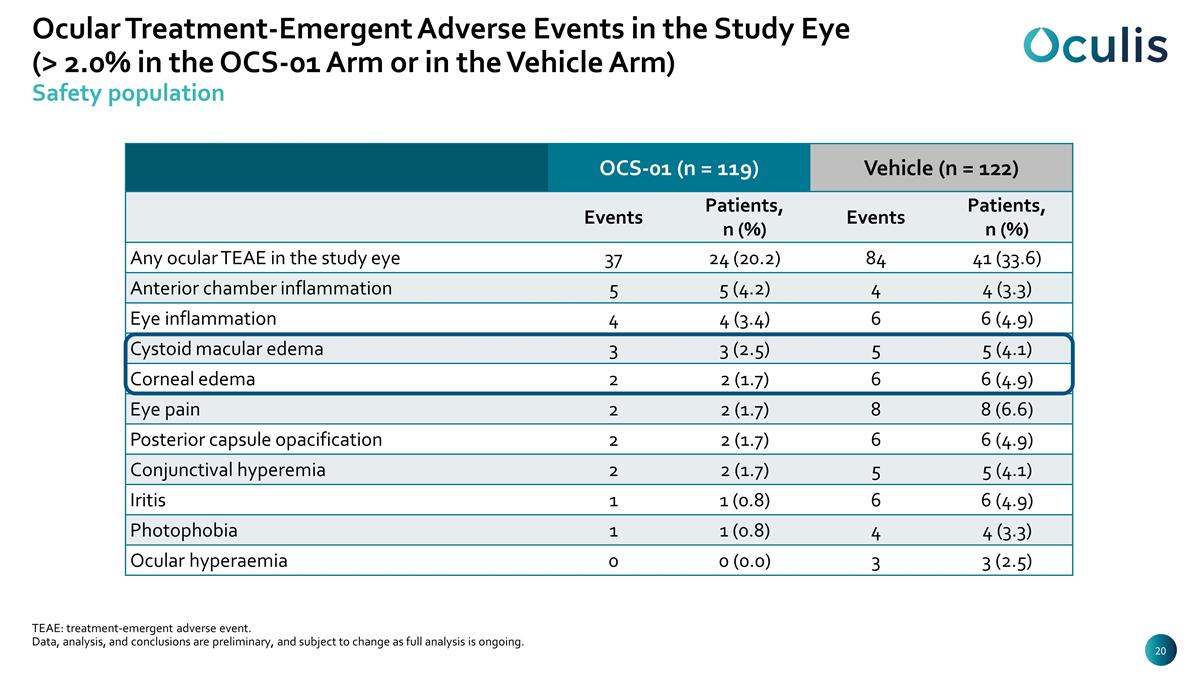
Ocular Treatment-Emergent Adverse Events in the Study Eye (> 2.0% in the OCS-01 Arm or in the Vehicle Arm) Safety population TEAE: treatment-emergent adverse event. Data, analysis, and conclusions are preliminary, and subject to change as full analysis is ongoing. OCS-01 (n = 119) Vehicle (n = 122) Events Patients, n (%) Events Patients, n (%) Any ocular TEAE in the study eye 37 24 (20.2) 84 41 (33.6) Anterior chamber inflammation 5 5 (4.2) 4 4 (3.3) Eye inflammation 4 4 (3.4) 6 6 (4.9) Cystoid macular edema 3 3 (2.5) 5 5 (4.1) Corneal edema 2 2 (1.7) 6 6 (4.9) Eye pain 2 2 (1.7) 8 8 (6.6) Posterior capsule opacification 2 2 (1.7) 6 6 (4.9) Conjunctival hyperemia 2 2 (1.7) 5 5 (4.1) Iritis 1 1 (0.8) 6 6 (4.9) Photophobia 1 1 (0.8) 4 4 (3.3) Ocular hyperaemia 0 0 (0.0) 3 3 (2.5)
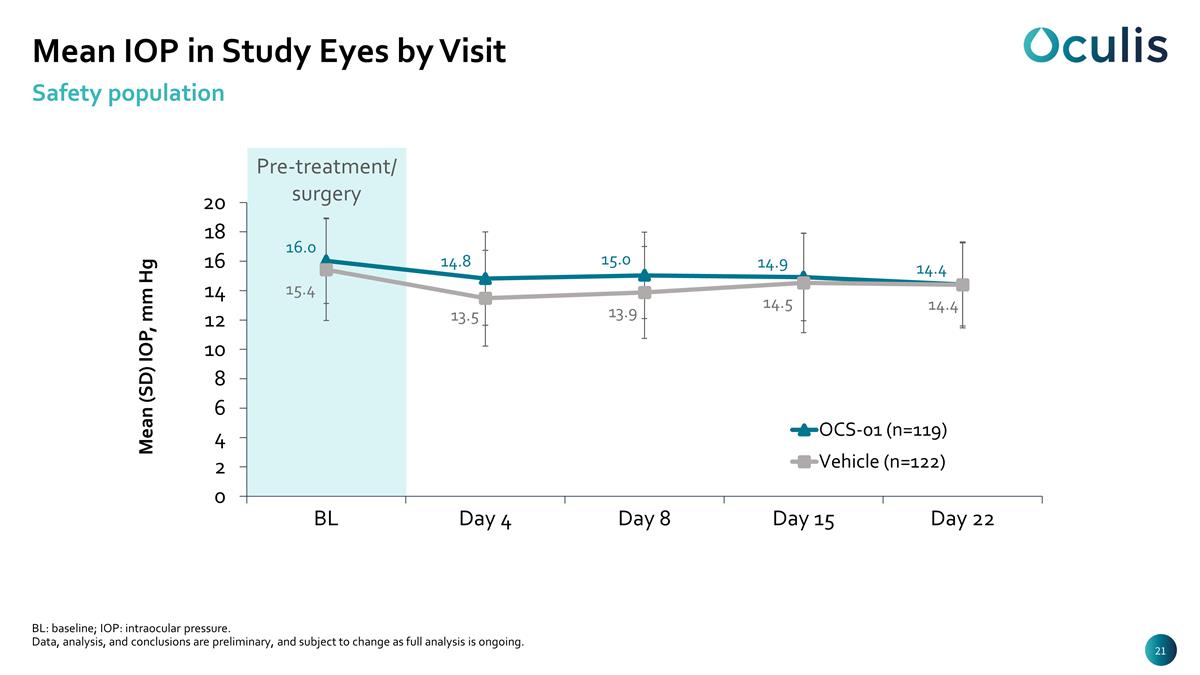
Pre-treatment/ surgery Mean IOP in Study Eyes by Visit Safety population BL: baseline; IOP: intraocular pressure. Data, analysis, and conclusions are preliminary, and subject to change as full analysis is ongoing.
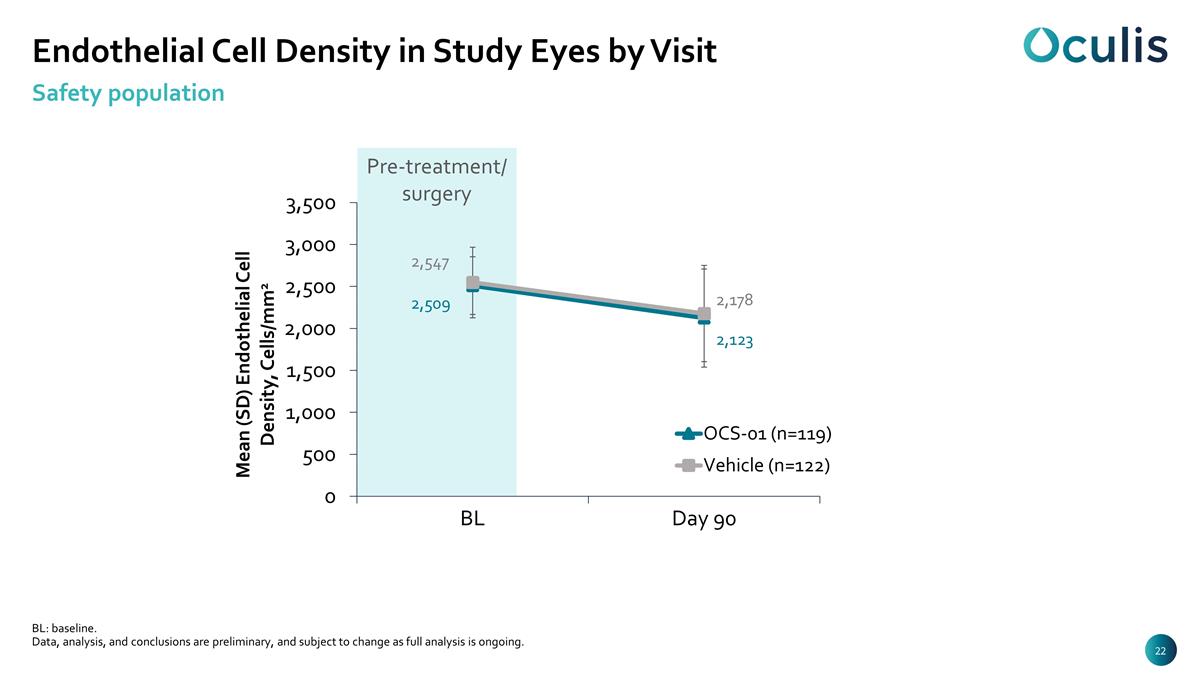
Pre-treatment/ surgery Endothelial Cell Density in Study Eyes by Visit Safety population BL: baseline. Data, analysis, and conclusions are preliminary, and subject to change as full analysis is ongoing.

Summary
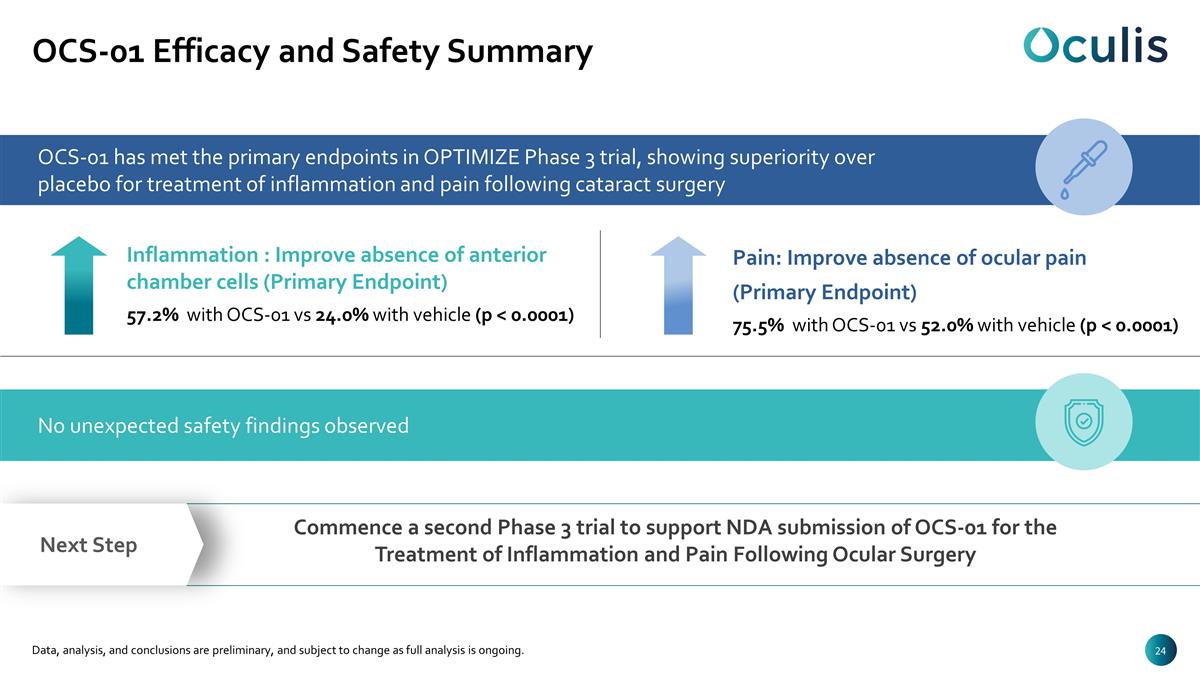
OCS-01 Efficacy and Safety Summary Data, analysis, and conclusions are preliminary, and subject to change as full analysis is ongoing. OCS-01 has met the primary endpoints in OPTIMIZE Phase 3 trial, showing superiority over placebo for treatment of inflammation and pain following cataract surgery No unexpected safety findings observed Inflammation : Improve absence of anterior chamber cells (Primary Endpoint) 57.2% with OCS-01 vs 24.0% with vehicle (p < 0.0001) Pain: Improve absence of ocular pain (Primary Endpoint) 75.5% with OCS-01 vs 52.0% with vehicle (p < 0.0001) Next Step Commence a second Phase 3 trial to support NDA submission of OCS-01 for the Treatment of Inflammation and Pain Following Ocular Surgery
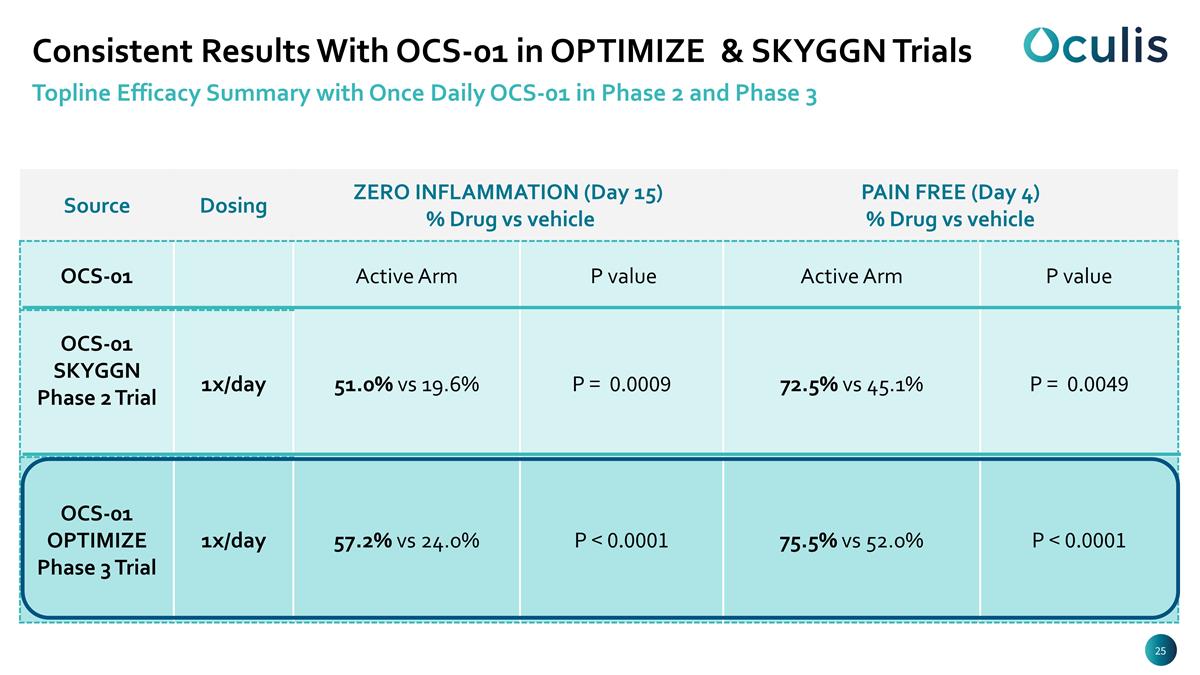
Source Dosing ZERO INFLAMMATION (Day 15) % Drug vs vehicle PAIN FREE (Day 4) % Drug vs vehicle OCS-01 Active Arm P value Active Arm P value OCS-01 SKYGGN Phase 2 Trial 1x/day 51.0% vs 19.6% P = 0.0009 72.5% vs 45.1% P = 0.0049 OCS-01 OPTIMIZE Phase 3 Trial 1x/day 57.2% vs 24.0% P < 0.0001 75.5% vs 52.0% P < 0.0001 Consistent Results With OCS-01 in OPTIMIZE & SKYGGN Trials Topline Efficacy Summary with Once Daily OCS-01 in Phase 2 and Phase 3
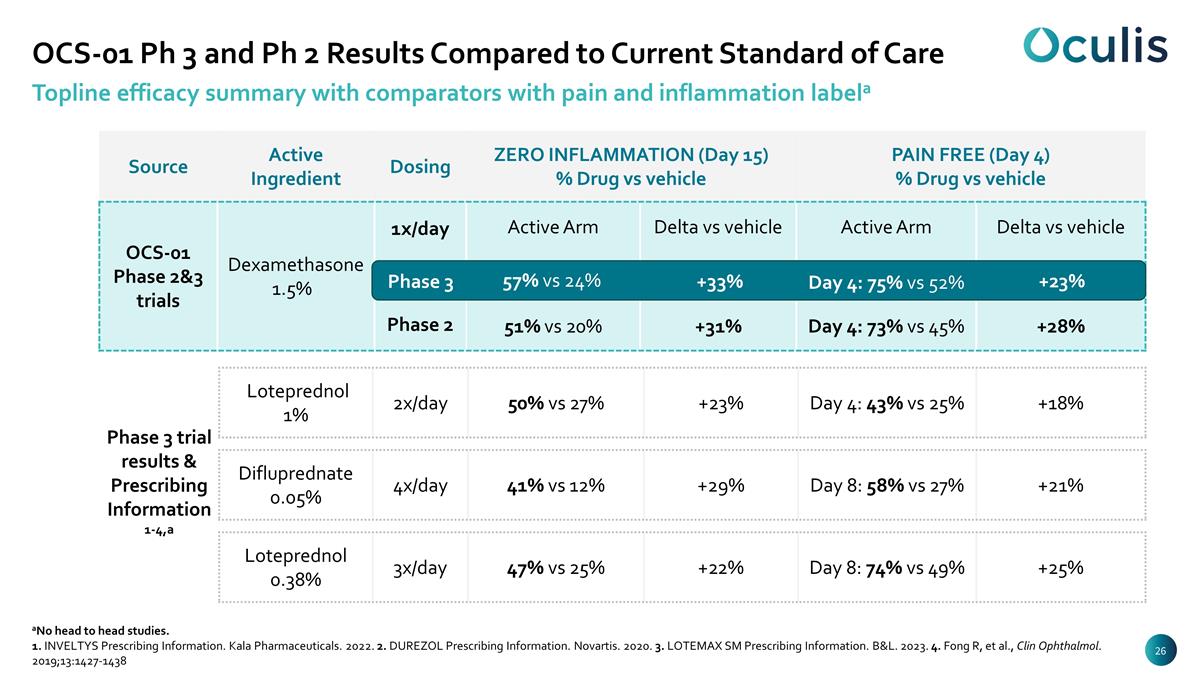
Phase 3 trial results & Prescribing Information1-4,a Loteprednol 1% 2x/day 50% vs 27% +23% Day 4: 43% vs 25% +18% Difluprednate 0.05% 4x/day 41% vs 12% +29% Day 8: 58% vs 27% +21% Loteprednol 0.38% 3x/day 47% vs 25% +22% Day 8: 74% vs 49% +25% OCS-01 Ph 3 and Ph 2 Results Compared to Current Standard of Care Topline efficacy summary with comparators with pain and inflammation labela aNo head to head studies. 1. INVELTYS Prescribing Information. Kala Pharmaceuticals. 2022. 2. DUREZOL Prescribing Information. Novartis. 2020. 3. LOTEMAX SM Prescribing Information. B&L. 2023. 4. Fong R, et al., Clin Ophthalmol. 2019;13:1427-1438 Source Active Ingredient Dosing ZERO INFLAMMATION (Day 15) % Drug vs vehicle PAIN FREE (Day 4) % Drug vs vehicle OCS-01 Phase 2&3 trials Dexamethasone 1.5% 1x/day Phase 3 Phase 2 Active Arm Delta vs vehicle Active Arm Delta vs vehicle 57% vs 24% +33% Day 4: 75% vs 52% +23% 51% vs 20% +31% Day 4: 73% vs 45% +28% Phase 3 57% vs 24% +33% Day 4: 75% vs 52% +23%
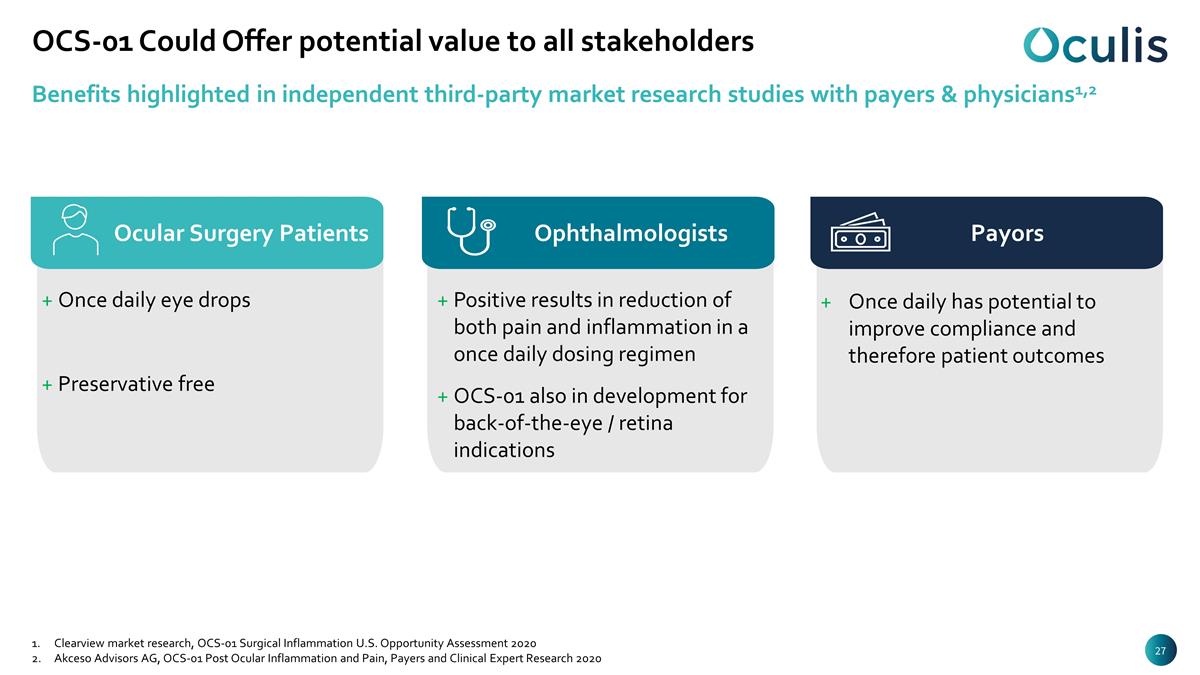
Benefits highlighted in independent third-party market research studies with payers & physicians1,2 Ophthalmologists Ocular Surgery Patients Payors Once daily has potential to improve compliance and therefore patient outcomes Positive results in reduction of both pain and inflammation in a once daily dosing regimen OCS-01 also in development for back-of-the-eye / retina indications Once daily eye drops Preservative free OCS-01 Could Offer potential value to all stakeholders Clearview market research, OCS-01 Surgical Inflammation U.S. Opportunity Assessment 2020 Akceso Advisors AG, OCS-01 Post Ocular Inflammation and Pain, Payers and Clinical Expert Research 2020
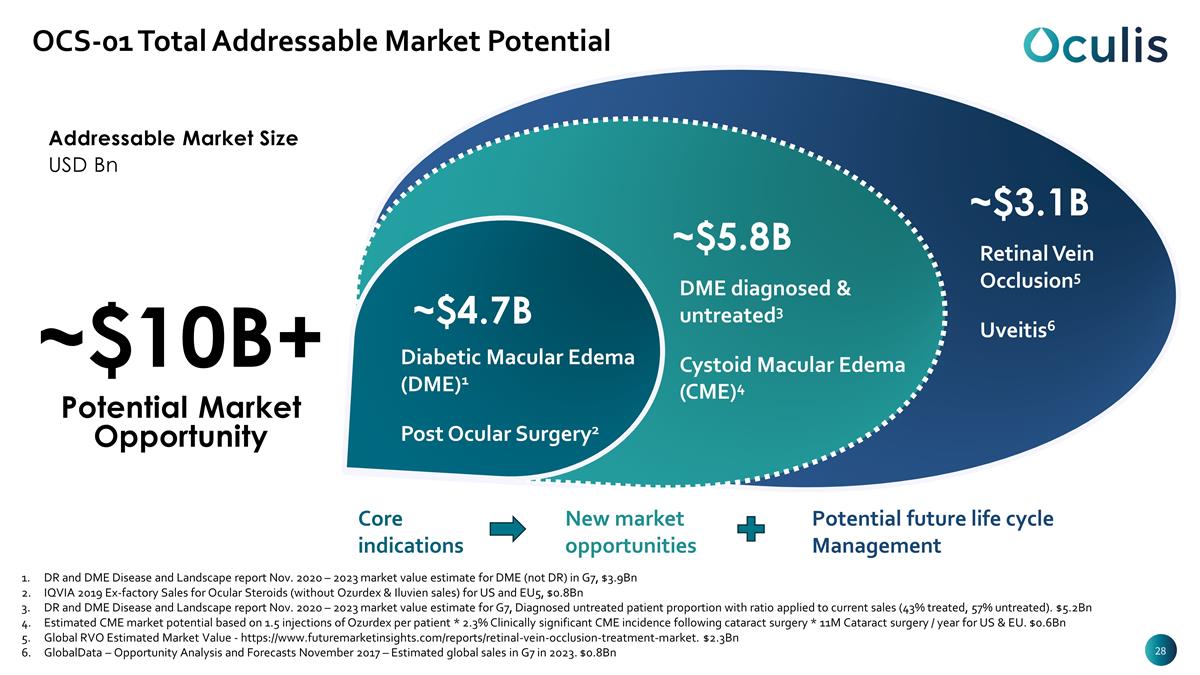
OCS-01 Total Addressable Market Potential $3.9B Current DME Market1 +$5.2B Potential DME Market1 Diagnosed & Untreated $922M US Ocular Steroids4 +$762M Potential CME Market5 +$753M Uveitis3 +$2.3B RVO2 ~$10B+ Potential Market Opportunity Addressable Market Size USD Bn ~$4.7B Diabetic Macular Edema (DME)1 Post Ocular Surgery2 ~$5.8B DME diagnosed & untreated3 Cystoid Macular Edema (CME)4 ~$3.1B Retinal Vein Occlusion5 Uveitis6 Core indications New market opportunities Potential future life cycle Management DR and DME Disease and Landscape report Nov. 2020 – 2023 market value estimate for DME (not DR) in G7, $3.9Bn IQVIA 2019 Ex-factory Sales for Ocular Steroids (without Ozurdex & Iluvien sales) for US and EU5, $0.8Bn DR and DME Disease and Landscape report Nov. 2020 – 2023 market value estimate for G7, Diagnosed untreated patient proportion with ratio applied to current sales (43% treated, 57% untreated). $5.2Bn Estimated CME market potential based on 1.5 injections of Ozurdex per patient * 2.3% Clinically significant CME incidence following cataract surgery * 11M Cataract surgery / year for US & EU. $0.6Bn Global RVO Estimated Market Value - https://www.futuremarketinsights.com/reports/retinal-vein-occlusion-treatment-market. $2.3Bn GlobalData – Opportunity Analysis and Forecasts November 2017 – Estimated global sales in G7 in 2023. $0.8Bn
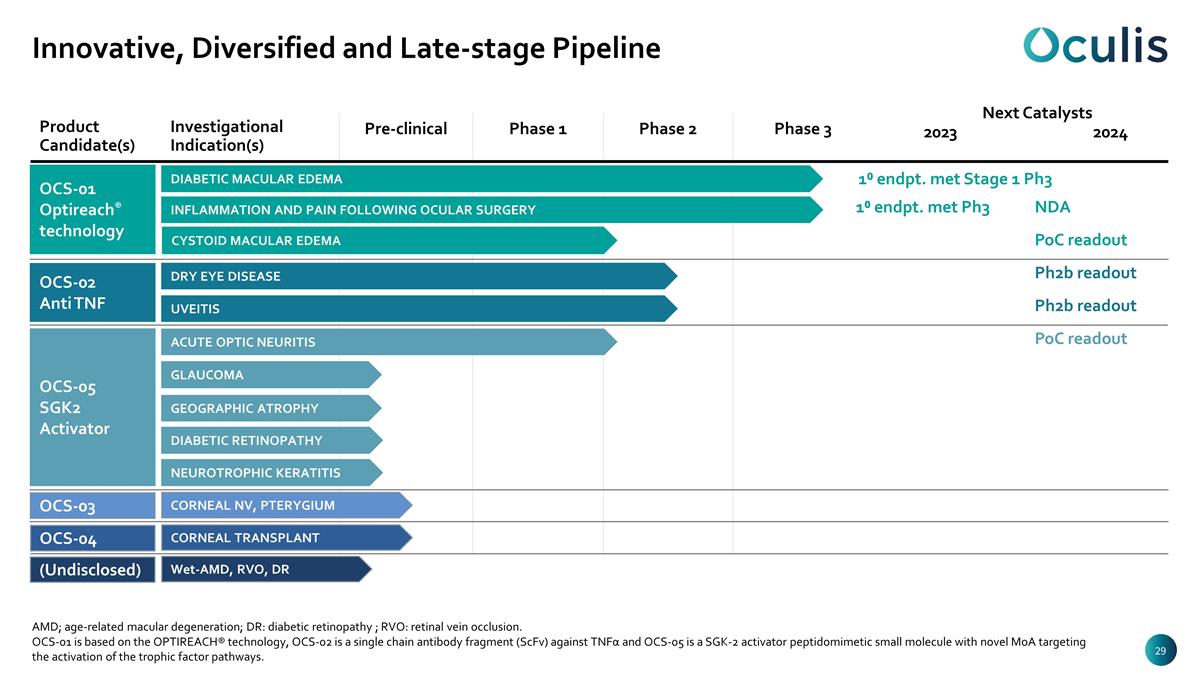
AMD; age-related macular degeneration; DR: diabetic retinopathy ; RVO: retinal vein occlusion. OCS-01 is based on the OPTIREACH® technology, OCS-02 is a single chain antibody fragment (ScFv) against TNFα and OCS-05 is a SGK-2 activator peptidomimetic small molecule with novel MoA targeting the activation of the trophic factor pathways. Product Candidate(s) Investigational Indication(s) Pre-clinical Phase 1 Phase 2 Phase 3 OCS-01 Optireach® technology OCS-02 Anti TNF OCS-05 SGK2 Activator OCS-03 (Undisclosed) DIABETIC MACULAR EDEMA INFLAMMATION AND PAIN FOLLOWING OCULAR SURGERY DRY EYE DISEASE UVEITIS ACUTE OPTIC NEURITIS GLAUCOMA DIABETIC RETINOPATHY CORNEAL NV, PTERYGIUM Wet-AMD, RVO, DR GEOGRAPHIC ATROPHY OCS-04 CORNEAL TRANSPLANT CYSTOID MACULAR EDEMA Innovative, Diversified and Late-stage Pipeline 2023 2024 1⁰ endpt. met Ph3 NDA PoC readout Ph2b readout Ph2b readout PoC readout Next Catalysts NEUROTROPHIC KERATITIS 1⁰ endpt. met Stage 1 Ph3
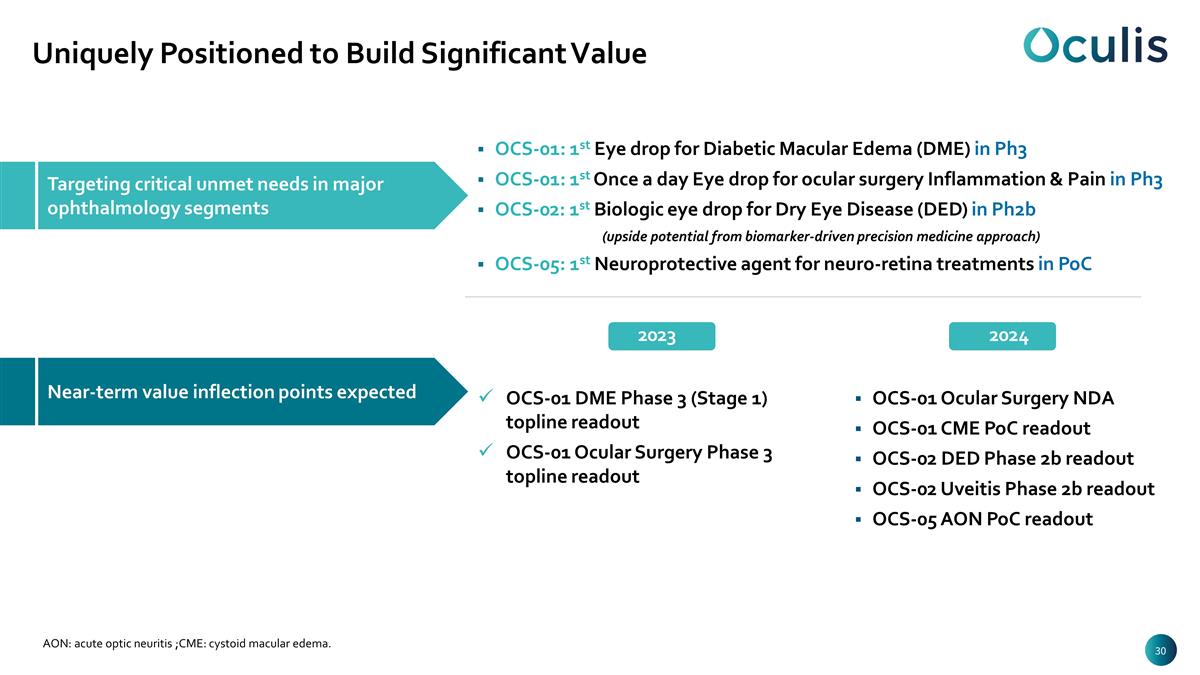
Uniquely Positioned to Build Significant Value Targeting critical unmet needs in major ophthalmology segments Near-term value inflection points expected AON: acute optic neuritis ;CME: cystoid macular edema. OCS-01: 1st Eye drop for Diabetic Macular Edema (DME) in Ph3 OCS-01: 1st Once a day Eye drop for ocular surgery Inflammation & Pain in Ph3 OCS-02: 1st Biologic eye drop for Dry Eye Disease (DED) in Ph2b (upside potential from biomarker-driven precision medicine approach) OCS-05: 1st Neuroprotective agent for neuro-retina treatments in PoC 2023 2024 OCS-01 DME Phase 3 (Stage 1) topline readout OCS-01 Ocular Surgery Phase 3 topline readout OCS-01 Ocular Surgery NDA OCS-01 CME PoC readout OCS-02 DED Phase 2b readout OCS-02 Uveitis Phase 2b readout OCS-05 AON PoC readout
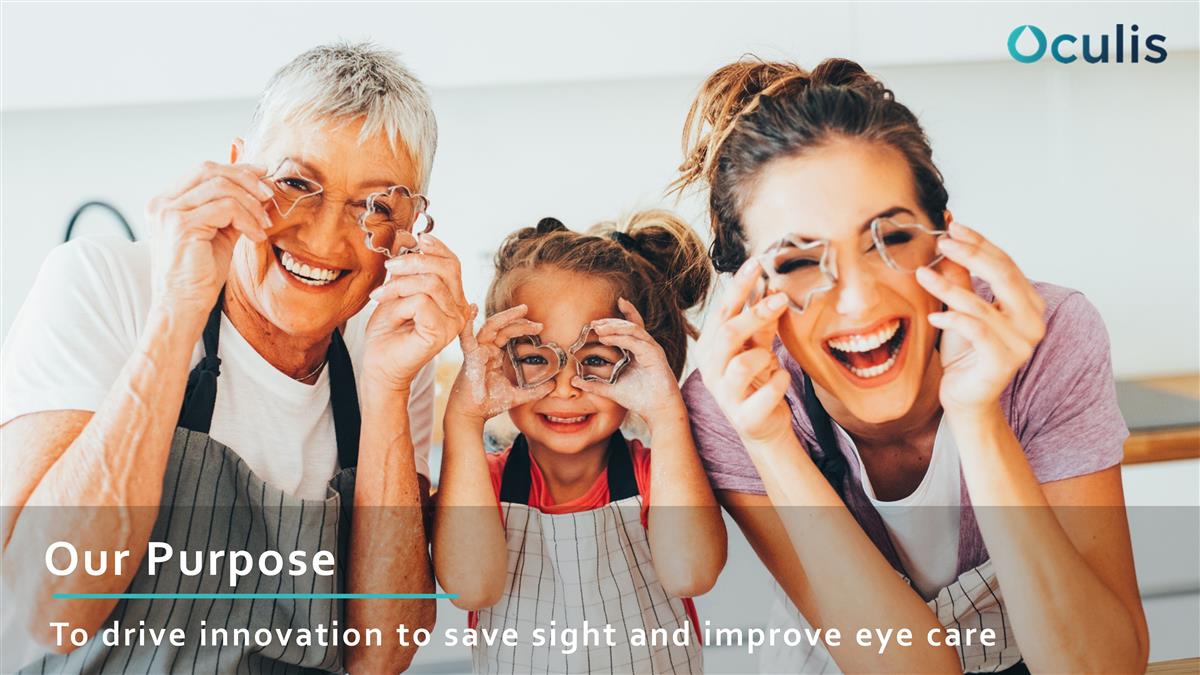
To drive innovation to save sight and improve eye care Our Purpose
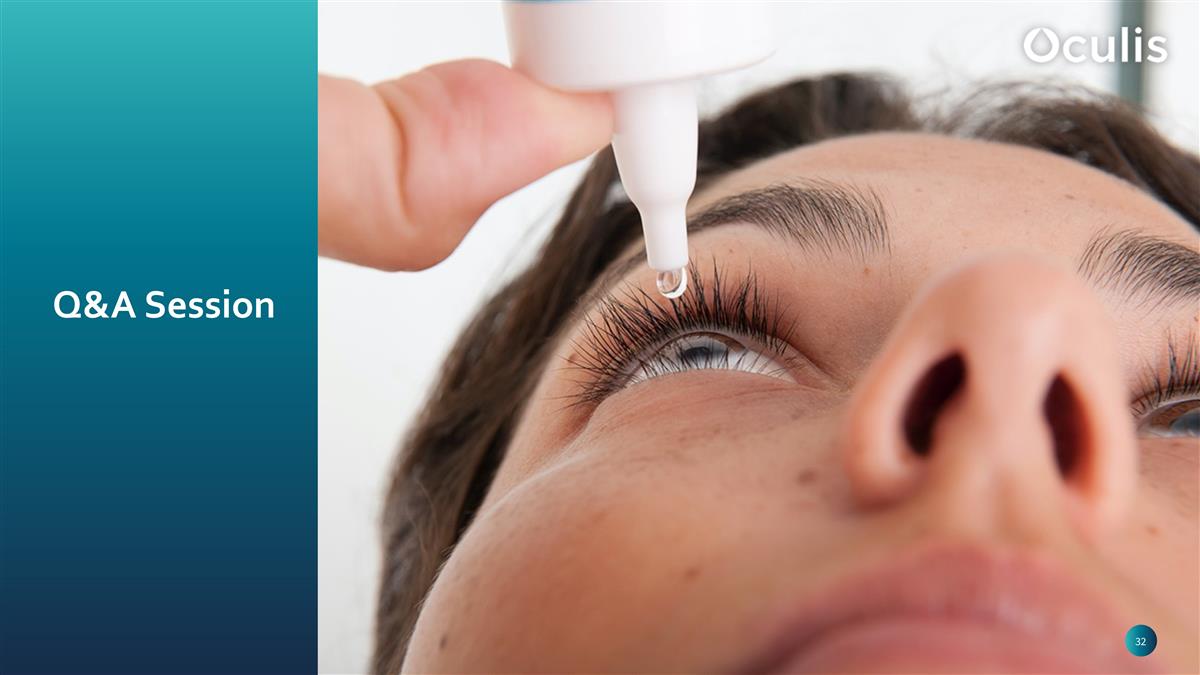
Q&A Session
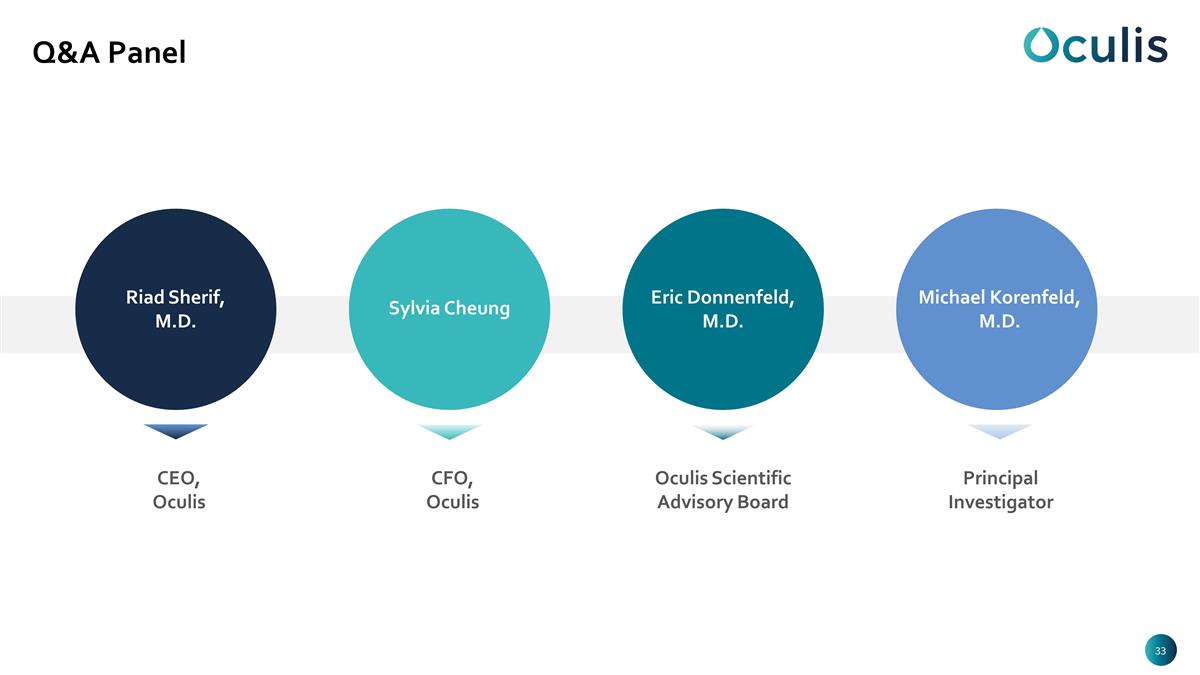
Q&A Panel Riad Sherif, M.D. Sylvia Cheung Eric Donnenfeld, M.D. Michael Korenfeld, M.D. CEO, Oculis CFO, Oculis Oculis Scientific Advisory Board Principal Investigator